Year: 2024
The U.S. Has One LGBTQ National Monument, and It Took a Lot to Get There
June 25, 2024
By: Abigail Nehring
What the Stonewall National Monument has meant for its Greenwich Village surroundings — and for the people tied to the property that started it all

The struggle for gay liberation reached a new milestone May 31 when Pride Live’s Ann Marie Gothard rang the closing bell at the New York Stock Exchange, signaling a level of mainstream acceptance the 12-year-old nonprofit’s founders would have thought unfathomable just a decade ago.
It’s no coincidence that in the intervening years the National Park Service designated the nation’s first LGBTQ National Monument at the site of the 1969 Stonewall uprising, and a series of other properties across the five boroughs were placed on the National Register of Historic Places or designated local landmarks. The list includes the onetime homes of James Baldwin, Alice Austen and Lorraine Hansberry, plus the Greenwich Village bar Julius’ and Columbia University’s Earl Hall.
And a grassroots historic preservation effort is now taking off in places like California and Colorado.
“I think it’s important that kids know their history, to include LGBT people in history,” said Mardi Moore, executive director of Rocky Mountain Equality in Boulder County, Colo. “That’s why if you go inside our boardroom, you’ll see a reproduction of the first same-sex marriage license.”
Moore, whose life in activism spans both her native Boulder and New York City, is part of a recent effort to landmark the Boulder County Courthouse, where a clerk named Clela Rorex issued that marriage license to two men in 1975. The site is currently working its way through the nomination process.
On its home turf in New York, Pride Live is now the driving force behind the monthlong celebrations — an economic boost for the city — that culminate in Stonewall Day at Hudson Yards, a music festival hosted annually underneath Related Companies’ temporarily closed, döner kabob-esque Vessel on 11th Avenue. The headliner this year will be actress and singer Cynthia Erivo.
But 2024 will be a special year for Pride Live. In addition to kicking off the weekend’s events — which include the Pride Parade, “Pride at the Shops & Restaurants” and other goings-on in New York City — June 28 will be the day the Stonewall National Monument Visitor Center opens its doors at 51 Christopher Street — the place where it all began 55 years ago.
“When you talk about property in New York, to be able to bring 51 Christopher back into the hands of the community, I think that’s just really important,” said Diana Rodriguez, co-founder and CEO of Pride Live. “It is such a significant space in LGBTQ history.”
Pride Live raised $3.2 million to bring the Stonewall visitor center into being, and it will manage the center separately, but in collaboration with the National Park Service, whose rangers camp out across the street at the 5,171-square-foot Christopher Park, which comprises the National Monument.
The nonprofit organization seized their opportunity when the previous retail tenant, a nail salon, departed 51 Christopher Street in 2018, leaving the storefront vacant for several years. Pride Live signed a lease in 2022 for 2,100 square feet on the ground floor of the building that the city landmarked in 2015, and later brought on EDG Architecture to handle its design.
The architects uncovered some treasures in the process, including a passageway between 51 and 53 Christopher Street that had been sealed over with bricks. Now it will be visible behind a plexiglass window that allows visitors to gaze directly into the past.
The newfound national visibility of this pair of low-slung former stable buildings with a conjoined Arts and Crafts-inspired brick and stucco façade could prove a long-term boon for landlord Alan Wasserman, who did not respond to a request for comment by press time.
But, in fact, when it comes to historic preservation and real estate investment, the Stonewall National Monument — the first and thus far only LGBTQ site in the country to be turned into an official national monument — is the exception to the rule.
“If you think of the landmarked property as an amenity, it does have the impact of raising property values in the surrounding area,” said Sam Chandan, director of the Chao-Hon Chen Institute for Global Real Estate Finance at the New York University Stern School of Business. “But the landmarking itself significantly reduces how you might deploy or develop the space, so there can be a sort of dis-amenity feature.”
In the case of the Stonewall Inn — ground zero for the new national embrace of LGBTQ history — the concomitant surge in foot traffic on this julienned corner of the Greenwich Village Historic District is not necessarily a value-add proposition for owners in the area.
Chandan said the data is ambiguous on the impact of congestion since “it may or may not be the case that folks want to live in an area that has special appeal for tourism.”
Wasserman decided to roll the dice on the Stonewall property in 2015, when he paid $56.5 million to buy the corner lot between Seventh Avenue and Waverly Place from Benjamin Duell through a limited liability company. It was the first time the property had changed hands in 45 years.
Duell’s father, Manny Duell, previously acquired it in 1970 for an unknown amount from the late Burt Handelsman, who was once a partner in the firm that owned 51-53 Christopher Street. Handelsman rented it to a trio of investors — allegedly affiliated with the Genovese crime family — who cobbled together $3,500 to open a private club in 1967 catering to gay men. Rather than invent a new name for their establishment, they borrowed one that already existed, calling it the Stonewall Inn after Bonnie’s Stonewall Inn, a tearoom that set up shop on the premises circa 1930.
This level of detail is known to us today thanks to the fastidious work of historian David Carter, the author of Stonewall: The Riots that Sparked the Gay Revolution and also a key mover in the effort beginning in the 1990s to permanently preserve the site and raise awareness about the events that took place there over six days from June 28 to July 3, 1969.
“Literally nobody was addressing this history through landmark designations, or even just talking about how we were an important community that had its own history,” said Jay Shockley, a former senior historian for the New York City Landmarks Preservation Commission. He was another member of the small circle of historic preservationists who got the landmark conversation going, along with Gale Harris, Andrew Dolkart and Ken Lustbader.
It’s a little-known paradox in the recondite world of historic preservation that the National Register of Historic Places, which contains some 90,000 sites and is overseen by the National Park Service, plays almost no role in shaping the fate of these sites or protecting them from real estate interests (outside of a narrow set of rules that apply only to federally funded development projects like interstate highways).
“The National Register is important because it recognizes nationally important sites, but it doesn’t have any teeth at all,” Shockley said. “It’s an honorary listing. So properties on the National Register can be demolished.”
But for Shockley and his co-conspirators, the Stonewall Inn was a launching pad for the larger LGBTQ landmarking effort they went on to launch officially in 2015, calling it the NYC LGBT Historic Sites Project.
The group decided to take their moonshot in 1999 when there was momentum to nominate Stonewall to the National Register before the end of the Clinton administration, according to Shockley. There was just one problem: Private property owners wield veto power in the nomination process, and the Duell family was not on board.
The solution they came up with was rather creative, and explains much of how the Stonewall National Monument is set up today.
“The idea that you would include the streets — and David Carter had done all this research — and that you could incorporate the battle for the streets, made it a much richer story in a way,” Gale Harris explained in a 2019 oral history interview.
It was exactly the model previous generations of preservationists had used to nominate Civil War battlefields to the National Register. The small group in New York City took that argument and ran with it, nominating not just the Stonewall Inn itself but also the surrounding streets and the triangle-shaped Christopher Park, which all belonged to the city and therefore deprived the Duell family of its veto power.
The application quickly passed through the state-level historic designation process and was placed on the National Register in 1999. It was then fast-tracked to become a national landmark — a smaller group of about 2,500 sites with greater symbolic significance — by December of the same year.

It took until 2015 for the wheels of historic preservation to turn enough for New York City to designate 51 and 53 Christopher Street local landmarks. Ironically, it’s the local Landmarks Preservation Commission that carries actual power to restrict land use on landmarked sites, and which can step into the process to review building permits before any alterations are made.
That’s when Jonathan Miller, president and CEO of real estate appraisal and consulting firm Miller Samuel, got involved to appraise the pair of buildings, a job he was happy to do pro bono, he said.
But he never finished the job because “the landlord said no, at the time they weren’t open to selling,” Miller said. “Plus, that would involve big fundraising.”
It didn’t matter. The city landmark designation, which the New York City Council passed in 2015, provides a robust set of protections. And, the following year, then-President Barack Obama officially proclaimed the park across the street a national monument.
The monument and visitor center will work synergistically, if all goes according to Pride Live’s plan.
The ragtag team of historians behind the NYC LGBT Historic Sites Project, too, is pushing on to new shores. The list of local LGBTQ landmarks now includes a number of asset types across the five boroughs, and the group is also trying to boost similar efforts underway in San Francisco, Los Angeles, Chicago, Boston and elsewhere across the country.
Miller has a poignant memory of visiting Stonewall about 10 years ago.
“I’m sitting there on a sunny day outside of the Stonewall Inn next to a man who was probably 6-foot-6 in a purple chiffon dress, and we chatted,” Miller said. “It just reminded me how awesome New York City is. I was wearing a dark suit, and it was so emblematic of the village.
“These events in history matter.”
LGBT Historians Partner with Bloomberg Connects to Create FREE Audio Tour of Stonewall and Surrounding Sites
June 25, 2024
PRESS CONTACT
Ken Lustbader, NYC LGBT Historic Sites Project
(917) 848-1776 / [email protected]
Audio Featuring First-hand Stories from History-Making Trailblazers and More
NEW YORK, NY—Tuesday, June 25, 2024—The NYC LGBT Historic Sites Project, an award-winning initiative committed to documenting and presenting historic sites connected to the LGBT community throughout New York City, announces the launch of their featured audio tours and more on the Bloomberg Connects mobile app.
“We’re thrilled to be among the newest cultural organizations and institutions invited to share on the Bloomberg Connects mobile app. Our digital guide has the power to immerse you in NYC’s LGBT history, from anywhere in the world.” — Amanda Davis, manager of the NYC LGBT Historic Sites Project
The Project’s content on the app features stories and historic images of LGBT historic sites — residences, bars, bookshops, community spaces, public places, businesses, and more. Engaging audio and video clips from the Project team, leading LGBT scholars, and activists who made LGBT history immerse you in history, from anywhere in the world.
“As historic preservationists with over 30 years of experience documenting LGBT history, we are proud to make an invisible history visible through our digital guide on the Bloomberg Connects app.” — Ken Lustbader, co-director of the NYC LGBT Historic Sites Project
CONNECT ANY TIME, FROM ANYWHERE
Take a self-guided audio tour in the vicinity of Stonewall National Monument, or explore thematic tours focusing on 1970s lesbian activism and transgender history (with more in development). Virtually visit the physical locations and streetscapes where LGBT history was made.

ENGAGING AND IMMERSIVE AUDIO

Ellen Broidy, activist and co-planner of the first ever Christopher Street Liberation Day March (today’s Pride March). “Craig [Rodwell] suddenly said, ‘it’s time to take some direct action.’ The more we talked, the clearer we could see the beginnings of what could be a mass movement.”

Author Hugh Ryan speaking about the extant Jefferson Market Courthouse and (since demolished) Women’s House of Detention. As Hugh shares, queer women and people who today might identify as nonbinary or transgender were prosecuted for “failures of femininity.”

Trailblazing gay rights activist Randy Wicker, who participated in the consequential “Sip-In” at Julius’ bar in 1966: “This was the first time a gay organization had publicly challenged the laws and regulations that forbid homosexuals to have access to public accommodations. It was against the liquor laws of New York State to allow any homosexuals to assemble or to be served alcohol in a bar.”
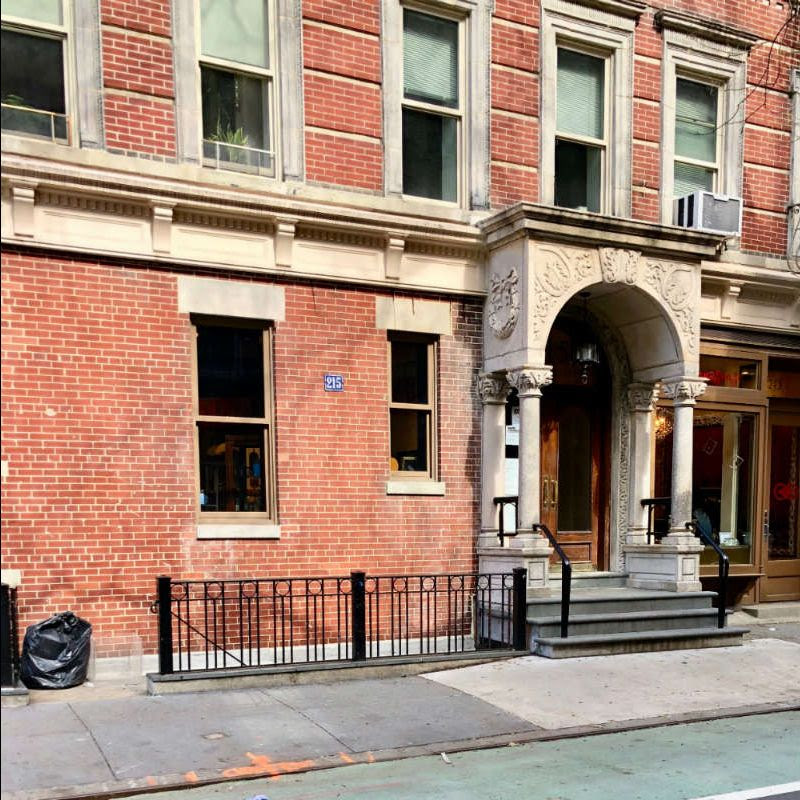
Project co-director Jay Shockley, sharing the events of the Snake Pit raid, which led to 167 gay men being arrested by the NYPD and one young man impaled on an iron fence: “Any way you look at it, that boy was pushed!! We are all being pushed.”

Project manager Amanda Davis, on the Oscar Wilde Memorial Bookshop, founded and owned by an “unsung hero of the LGBTQ rights movement,” Craig Rodwell. In the face of mainstream propaganda that said being LGBTQ was wrong, one could walk into the Bookshop “and read books that are saying exactly the opposite [which] must have been so incredible.”

Project co-director Ken Lustbader, narrating your visit to the Stonewall Inn, the site of the history-changing uprising in June 1969: “When you oppress people for so long, when you tell them that their lives aren’t legitimate, and you tell them that their identity isn’t real, it only takes a little moment to have an explosive response.”
PREVIEW FROM FEATURED AUDIO TOUR, “PLACING STONEWALL”:
LGBTQ+ activism didn’t begin at Stonewall, and it didn’t end there either.
It’s location in Greenwich Village is key in placing the 1969 uprising in LGBTQ+ history. An early “gayborhood,” the Village has been an important epicenter of LGBTQ+ life in New York City for well over a century.
In the pre-Stonewall years, amidst an atmosphere of fear and repression, gay bars and other social gathering spaces were crucial in creating a sense of community and brewing political agitation. Though discrimination remained post-Stonewall, the gay liberation era of the early 1970s ushered in a new wave of unapologetic activism and increased visibility.

About the NYC LGBT Historic Sites Project
The NYC LGBT Historic Sites Project, launched in 2015 by preservation professionals, is an award-winning cultural heritage initiative and educational resource documenting and presenting historic sites connected to the LGBT community throughout New York City. Its website, including an interactive map, features 450+ diverse places from the 17th century to 2000 that are important to LGBT history and illustrate the community’s influence on NYC and American culture.
The project researches and nominates LGBT sites to the National Register, advocates for the official recognition of LGBT historic sites, provides walking tours (also accessible through a free-app), presents lectures, engages the community through events, develops educational programs for New York City public school students, and disseminates its content through robust social media channels. Its goal is to make an invisible history visible while fostering pride and awareness.
Web: www.nyclgbtsites.org
Instagram: @nyclgbtsites
Twitter: @nyclgbtsites
Facebook: /nyclgbtsites
New York Times: “5 Places to Visit for Pride in New York”
June 17, 2024
By: Ainara Tiefenthäler

The New York Times has a newly-published guide about places to visit in New York City during Pride 2024, and talked to Project co-director Ken Lustbader about Woodlawn Cemetery’s importance as a final resting place for important LGBT figures.
“It’s moving to know that there were people who lived these lives very bravely, heroically in the past,” said Ken Lustbader, a co-founder of the NYC LGBT Historic Sites Project. “Without the support systems that exist today, but paving the way for the visibility and allies that we have today through their actions.”
Each year for Pride, his organization offers a trolley tour of the [Woodlawn] cemetery, highlighting the stories behind some of the burial sites and making them more visible by placing rainbow flags next to them.
For the full article, visit the New York Times.
WALKING TOUR: Lesbian Herstory of Greenwich Village
June 27, 2024 | 6 PM
Under the Arch in Washington Square Park
Washington Square Park
View on Google Maps
Join us for stroll of Greenwich Village as we explore the lesbian community’s connections to one of the world’s most famous neighborhoods. We’ll cover places that speak to the evolution of the lesbian bar, from the 1910s onward, and gathering spots run by women for women that popped up in the Village in the 1970s. Stops along the way include the former homes of notable lesbians who have helped shape American history and culture.
The tour will last approximately 1 1/2 hours. Meet under the Arch in Washington Square Park. Walking tour will take place rain or shine.
To register groups of 5 or more, please contact us at [email protected].
CLICK HERE TO REGISTER
This is a FUNDRAISING tour; all money raised will support the ongoing work of the NYC LGBT Historic Sites Project.
Select events are funded, in part, by grants from Consolidated Edison, New York Community Trust, New York State Council on the Arts with the support of the Office of the Governor and the New York State Legislature, and New York City Tourism Foundation.
STONEWALL: Greenwich Village LGBT History Tour
June 25, 2024 | 6PM
Stonewall National Monument
Christopher Street at West 4th Street, New York, NY
View on Google Maps
Pride is celebrated to commemorate the 1969 Stonewall uprising, a key turning point in the LGBT rights movement. In its immediate aftermath, new activist groups emerged fighting for liberation and visibility. However, New York City has a long and vibrant LGBT history dating to the early 20th century. Join Ken Lustbader and Jay Shockley, co-directors of the NYC LGBT Historic Sites Project, and Amanda Davis, project manager, for an LGBT walking tour of Greenwich Village. Starting at the Stonewall National Monument, learn about the LGBT presence in the Bohemian Village and hear about the places and people of the pre- and post-Stonewall LGBT civil rights movement and their lasting impact on American culture. The tour will also highlight the importance of these sites to a marginalized community that oftentimes had nowhere else to go to fully be themselves. Stops will include places connected to such groups as the Salsa Soul Sisters, Mattachine Society, and the Gay Liberation Front, and to the LGBT activists, artists, and business owners who found refuge in the Village since the late 19th century.
To register groups of 5 or more, please contact us at [email protected].
REGISTER HERE>
This is a FUNDRAISING tour; all money raised will support the ongoing work of the NYC LGBT Historic Sites Project.
Tour starts at Christopher Park / Stonewall National Monument, Christopher Street at West 4th Street, in Greenwich Village. Walking tour will take place rain or shine.
Select events are funded, in part, by grants from Consolidated Edison, New York Community Trust, New York State Council on the Arts with the support of the Office of the Governor and the New York State Legislature, and New York City Tourism Foundation.
TROLLEY TOUR: The Bronx’s Woodlawn Cemetery
June 22, 2024 | 12 PM
Woodlawn Cemetery, The Bronx
Gate at Jerome Avenue and Bainbridge Avenue
View on Google Maps
Woodlawn Cemetery and the NYC LGBT Historic Sites Project celebrate Pride Month with a special trolley tour illuminating LGBT permanent residents who have made a lasting impact on American culture in the 19th and 20th centuries. Join us as we share stories about love, loss, and relationships on our annual tour. We’ll visit the final resting places of Harlem Renaissance poet Countee Cullen, illustrator Joseph Leyendecker, theatrical agent Elisabeth Marbury, and photographer George Platt Lynes. Patricia Cronin’s well-known sculpture “Memorial to a Marriage” is a highlight of this tour. The tour will be co-led by Jay Shockley, Project co-director; Amanda Davis, manager of the NYC LGBT Historic Sites Project; and Susan Olsen, Director of Historical Services at Woodlawn Cemetery.
CLICK HERE TO REGISTER
Memory-Sharing Meetup at the former Oscar Wilde Memorial Bookshop
June 21, 2024 | 5 PM
former Oscar Wilde Memorial Bookshop
15 Christopher Street
View on Google Maps
Did you shop at the Oscar Wilde Memorial Bookshop (at either location!)? We’re sounding a “call for memories” from former customers and supporters with an informal memory-sharing meetup and recording session outside the former location of what was the second location of the trailblazing bookstore. All are invited to meet Project manager Amanda Davis and our communications team outside 15 Christopher Street where we’ll record (lo-fi on iPhones) your recollections of this important community space. Swing by for 10 minutes, say hi, share your story!
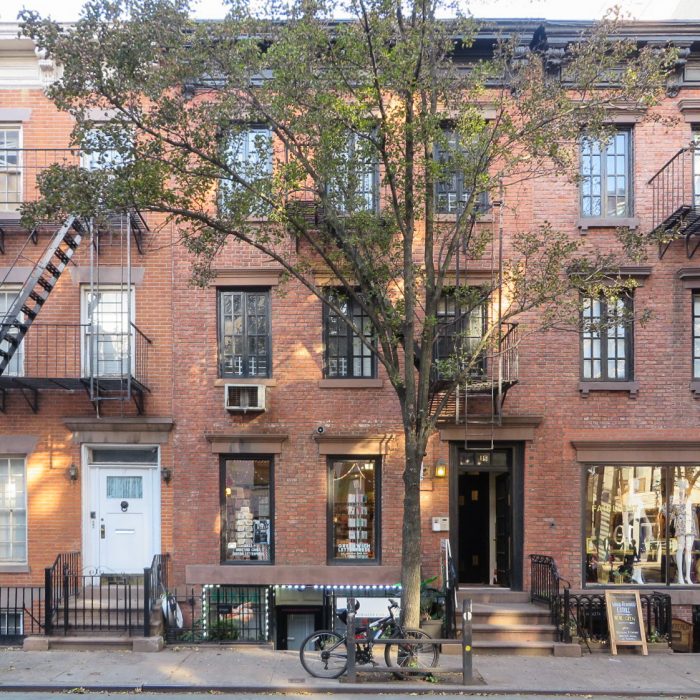
In 1973, Craig Rodwell moved his Oscar Wilde Memorial Bookshop, the first gay and lesbian bookstore on the East Coast (and the first of its kind in the nation to operate long term), from its original home on Mercer Street to a prominent location on Christopher Street, near the center of New York City’s gay life. The shop, which also served as a vital community center, occupied this site for over 35 years.
ARTISTIC HOMES: Queer Landmarks and Public Interpretation
June 20, 2024 | 6:30 PM
Drawing Room of the New York Studio School, 8 West 8th St, New York, NY

LGBTQ artists have played a major role in influencing American cultural life, yet their personal identities are typically not presented when visitors explore their historic studios and homes.
Efforts to correct these omissions are at the forefront of the movement to landmark and celebrate significant LGBTQ sites, including historic house museums. Many of these sites are now working to document and interpret the one-time residents to reflect their true lives, loves, friendships, and influences. The process from research, through official designation, to changes in public programs and interpretation is a complex journey and the reception in local communities can vary. In this Pride Month, three historic house museums in the art and design worlds—The Glass House, the Alice Austen House, and the Demuth Museum—are coming together to discuss this process and how telling the full story of their history has been received.
The event will be moderated by Ken Lustbader, co-director of the NYC LGBT Historic Sites Project.
CLICK HERE TO REGISTER
Speakers
Abby Baer, Executive Director, Demuth Museum
Victoria Munro, Executive Director, Alice Austen House
Kirsten Reoch, Executive Director, The Glass House
For discounted student tickets ($15), please enter promotional code GHPSTUDENT when making reservations. In partnership with Historic Artists’ Homes and Studios, a program of the National Trust for Historic Preservation. Hosted by the New York Studio School.
Photo: Glass House, exterior.
NJ History & Historic Preservation Conference
June 6, 2024 | 1:30 PM
Gothic Lounge (Conference Room 202 in Hepburn Hall), New Jersey City University, Jersey City, NJ
 Panel: LGBTQ+ Historic Sites: Featuring the Venus Pellagatti Xtravaganza House
Panel: LGBTQ+ Historic Sites: Featuring the Venus Pellagatti Xtravaganza House
The State of New Jersey has a rich LGBTQ (Lesbian, Gay, Bisexual, Transgender, and Queer) history, yet the numerous historic sites associated with these places, events, and people are often not recognized or preserved. Throughout the country, the historic preservation profession is striving to weave more of these important threads into our cultural narrative. This session highlights the 2023 Jersey City local designation of the Venus Pellagatti Xtravaganza House, the first LGBTQ designated site in New Jersey. Panelists will discuss Venus’ story, explore ballroom culture, and investigate the challenges and opportunities in identifying and commemorating LGBTQ site-based resources more widely.
Speakers
MODERATOR: Ken Lustbader | Project co-director, NYC LGBT Historic Sites Project
PRESENTERS: Daniella Carter| LGBTQ+ youth advocate, director and producer
Michael Roberson| public health practitioner, advocate, activist, artist and community leader
On Harvey Milk Day, remember his New York roots
May 22, 2024
By: Matt Tracy

WIKIMEDIA COMMONS/DANIEL NICOLETT
The late Harvey Milk became known for his work in the Castro neighborhood of San Francisco: That was where he opened a business, built political power, and made history when he won an election to become a city supervisor. As the nation marks Harvey Milk Day on May 22, many pictures circulating social media show him engaging in gay rights activism against the backdrop of the Bay area.
However, what is not as widely known is that the gay political icon spent the first four decades of his life in New York State. He grew up in Long Island — first in Nassau County before graduating high school in Suffolk County — and went on to attend college at what is now known as SUNY Albany, where he received a Bachelor’s Degree. He later became a teacher in Long Island and worked in finance in Manhattan.
Some of Milk’s earliest known gay experiences were based in New York City. According to Randy Shilts’ book, “The Mayor of Castro Street: The Life and Times of Harvey Milk,” Milk met his future partner, Joe Campbell, in the summer of 1956 at Riis Beach — a popular oceanside LGBTQ hangout spot in Queens.
“A few weeks later, Joe left home and moved into Harvey Milk’s apartment in suburban Rego Park,” the book stated (Rego Park is actually within the confines of Queens).
Years before that, in 1947, Milk was busted for cruising in Central Park, according to Shilts.
When he was still in New York, Milk was also romantically involved with Craig Rodwell, who founded the Oscar Wilde Memorial Bookshop and made waves as a gay rights activist, participating in demonstrations such as the “sip-in” at Julius’ Bar that helped eliminate state liquor policies barring the sale of alcohol to gay people. Milk met Rodwell in Central Park, Shilts wrote.
Milk subsequently moved several times — even returning to New York — as he continued to refine his identity before settling in San Francisco.
Milk made his mark on the Big Apple — and the non-profit NYC LGBT Historic Sites Project outlined several places in the city associated with Milk during the years before he went out west.
One of the historic sites is 360 Central Park West, where Milk and Campbell lived in an apartment from 1958 to 1962, according to the NYC LGBT Historic Sites Project, which noted that Milk lived there for another year after the couple broke up. The apartment was across the street from Central Park on a street corner near W. 96th St., just steps from what is now the 96th St. B and C subway station.
The NYC LGBT Historic Sites Project also lists Central Park as one of the locations tied to Milk — which makes sense given that Milk was arrested there for cruising and where he met Rodwell. Central Park is also historically known as a popular cruising spot for gay men.
Another location associated with Milk is 2 Astor Pl., which was where Milk posthumously made what was arguably his most significant contribution to New York’s LGBTQ community. That location later became the site of Harvey Milk High School thanks to the work of the Institute for the Protection of Lesbian and Gay Youth, which later became the Hetrick Martin Institute.
One more historic site with links to Milk is 112 E. 3rd St., which was where the Institute for the Protection of Lesbian and Gay Youth opened its first office — ultimately paving the way for the school that would be named after Milk.
While he led a quieter life in New York, Milk embraced his sexuality and became more visible once he moved to San Francisco. In 1977, he became the first out gay man elected to public office in California, but he was assassinated a year later when he and Mayor George Moscone were shot and killed by City Supervisor Dan White.
LGBTQ New Yorkers and electeds urge CB5 to condemn anti-trans education council resolution
April 12, 2024
By: Matt Tracy
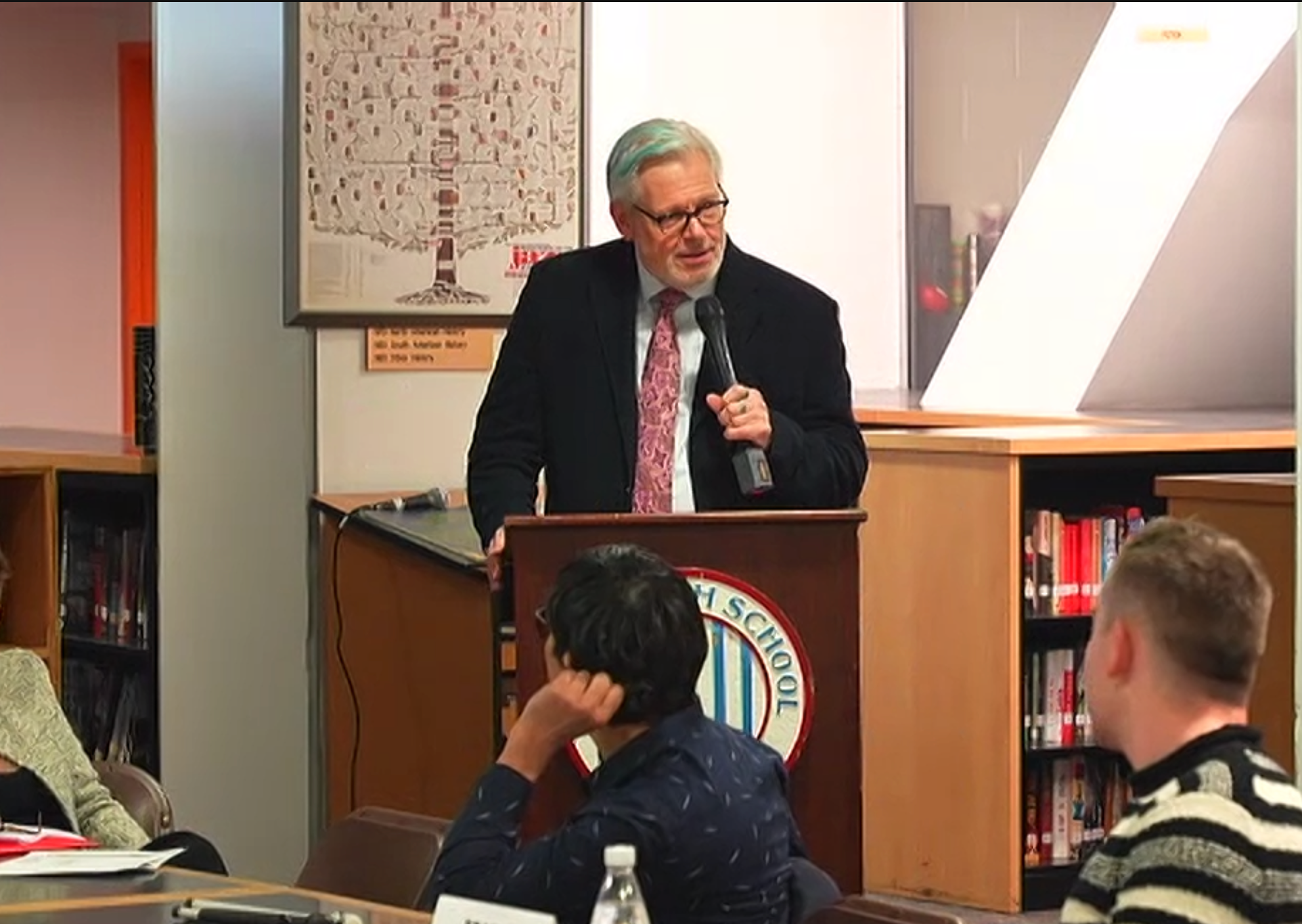
One by one, LGBTQ New Yorkers and elected officials spoke up during Manhattan Community Board 5’s meeting at Xavier High School on April 11 to urge its members to formally condemn an anti-trans sports resolution approved by Community Education Council District 2 (CEC2) last month.
The meeting represented the latest development in the aftermath of CEC2’s widely-criticized March 20 resolution, which called for a new committee that could review and potentially oppose trans inclusion in school sports. The resolution was non-binding and New York education officials have reaffirmed that students can play sports in accordance with their gender identity, but the vote nonetheless sparked concern that the national backlash against trans athletes could gain steam in New York — especially after Nassau County Executive Bruce Blakeman fueled outrage with an executive order barring trans athletes from using sports facilities in the county.
Community education councils, which are separate from the Department of Education, are meant to give members of the public an opportunity to speak out about school-related issues — and some CEC2 schools are located in the same district as Community Board 5, which stretches from 59th Street down to 14th Street between Eighth Avenue and Lexington Avenue. Community boards also play an advisory role and consist of 50 members appointed by the borough president and city lawmakers.
The Stonewall Democratic Club of New York City, a citywide LGBTQ political club, and the statewide education and advocacy non-profit New Pride Agenda showed up in force at Community Board 5’s meeting to encourage members to pass a resolution of their own condemning the education council’s resolution.
“I’m here to profess my profound disappointment in the actions of CEC2 and the resolution that seeks to keep transgender kids from participating in sports aligned with their gender identity,” said Cathy Marino-Thomas, a member of Stonewall and a longtime LGBTQ activist who previously served as the executive director and later the board chair of Marriage Equality NY.
Marino-Thomas called on the board to “take a stand against discrimination” by issuing its own resolution in opposition to the CEC2 vote.
“As a queer mother, I understand the importance of creating an inclusive and supportive environment for our children regardless of their gender identity,” Marino-Thomas said. “Allowing transgender children to have the opportunity to participate in sports teams that align with their gender identity is not only a matter of basic human rights, it is also a crucial step toward fostering a sense of belonging and acceptance.”
Stonewall board member Caleb Simmons, who works in the district, also slammed the resolution, saying such a policy would “rob” trans student-athletes of the “crucial childhood experience of fostering connection and a sense of shared belonging.”
“Please do not allow bigots to hijack prestigious bodies such as yours,” Simmons said.
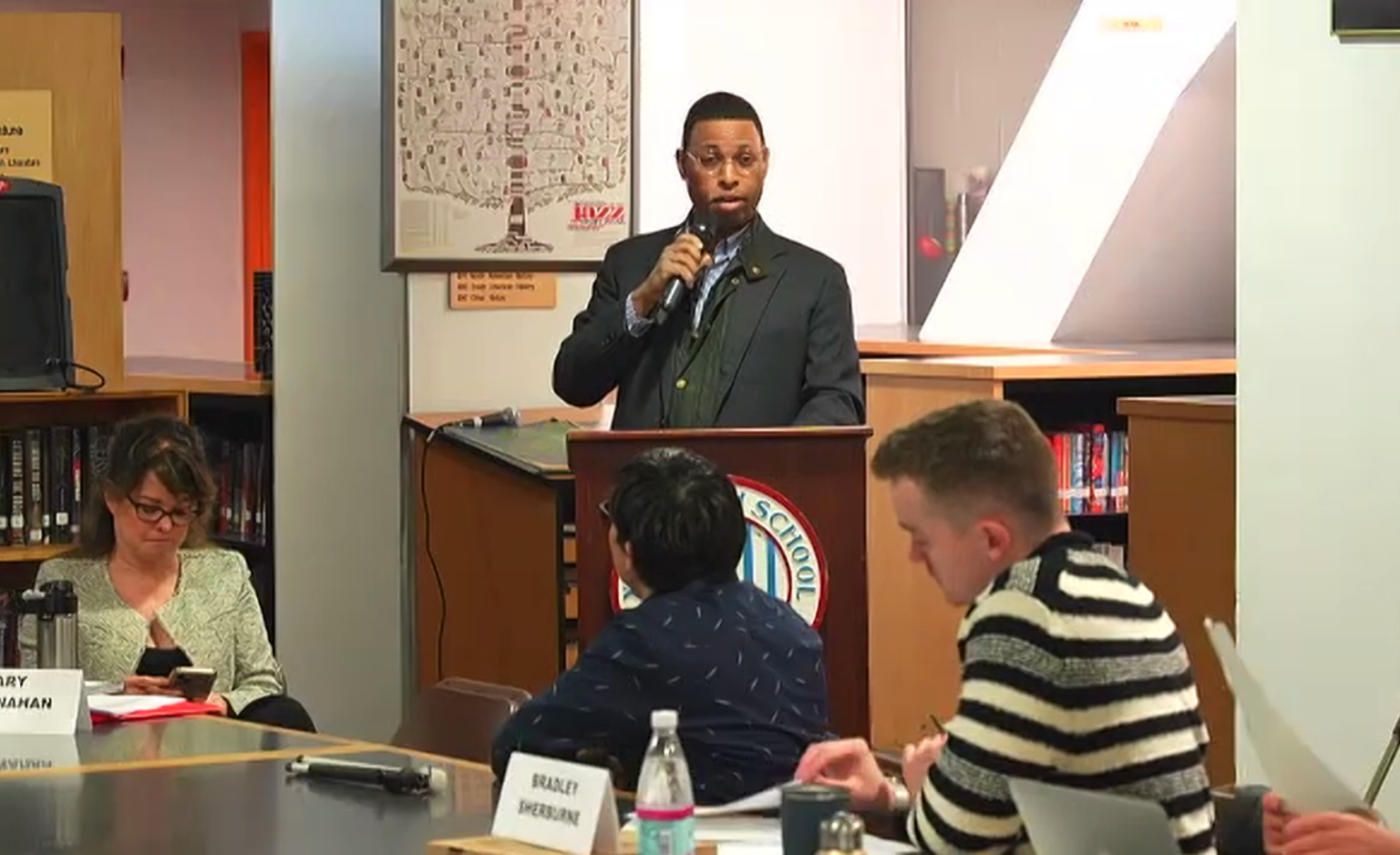
Elisa Crespo, the executive director of New Pride Agenda, joined the meeting virtually to denounce what she described as “a troubling trend that’s happening in our city,” referring to the CEC2 resolution. The resolution, she said, sends a signal to young people — especially trans youth — that they do not belong in sports.
“The fact is that trans youth deserve to play sports that align with their gender identity and the crisis that we’re seeing play out is completely manufactured and not based in fact,” Crespo said. “We in New York City must speak up. We must let anti-trans folks know that it is not OK in New York City.”
Out gay former State Senator Thomas Duane — the first out member of the State Legislature and one of two of the first out members of the City Council — delivered impassioned remarks in support of young trans athletes as he called on the community board to take a strong stand against the CEC2 resolution.
“Whoever wrote this hopes they’ll do damaging things to children,” Duane said before pausing and slowing down for emphasis. “Not allowing children to play sports among people of their gender is wrong, unhealthy, and we’re not in Arizona in the 1800s.”
Duane reminded attendees that he sponsored the Dignity for All Students Act, a law which protects LGBTQ students in New York State, and he pointed to the great deal of research affirming transgender youth as he made his case.
“Every scientific, every psychological association, every psychiatrist, the medical associations, the NIH… all say that those who participate in sport should participate with the gender in which they feel most comfortable,” said Duane, who added that “this issue has been studied to death.”
Duane said he would be in attendance when the board opts to vote on the issue in the future. Samir Lavingia, the chair of Community Board 5, told Gay City News the board does not have a position on CEC2’s resolution and will need to discuss it and vote on it before taking a stance.
“I am speaking to the chair of the relevant committee to discuss the path forward on this item and we are hoping to get this onto the Budget, Education & City Services Committee meeting agenda at the end of the month on April 30,” Lavingia said.
The controversy has brought renewed attention to the backgrounds of some CEC2 members, including Maud Maron, who spoke at a Moms for Liberty event in January and was a sponsor of CEC2’s anti-trans sports resolution. Craig Slutzkin, who is listed as the second vice chair of Community Board 5, is also a listed as member of CEC2. Although the vote breakdown on the anti-trans sports resolution has not been posted publicly, Queens Chronicle reported that Slutzkin, who is president of Townsend Harris High School’s alumni association, has faced backlash from students at that school who signed a petition criticizing his vote in support of the resolution. According to Queens Chronicle, Slutzkin defended his vote by saying that the resolution sought to give “families a safe forum to have respectful yet difficult conversations about how school sports are organized” and that “there was no call for any bans.”
Gabriel Lewenstein, who was elected president of Stonewall earlier this year, told Gay City News on April 12 that members of the political club and New Pride Agenda felt it was important to attend the meeting to ramp up pressure on the board to take action against CEC2’s resolution, which he is concerned could contribute to bullying and harassment against trans youth.
“In Manhattan, the heart of New York City, the birthplace of the modern LGBTQ rights movement, this community supports LGBTQ people and supports trans kids,” said Lewenstein, who added that advocates wanted the board to send a message to trans kids that they are “welcome and allowed to be who they are.”
Elected officials who spoke out against the CEC2 resolution during the meeting included Manhattan Borough President Mark Levine, Manhattan Assemblymember Harvey Epstein, and Manhattan Councilmember Erik Bottcher.
Other community boards are also in the process of developing a response to the CEC2 resolution, including Manhattan’s Community Board 2, which told Gay City News that its Arts, Culture, Education, and School Committee on April 8 voted to recommend a letter in opposition to the resolution. Bottcher also noted that Community Board 4 is working on a resolution in response to CEC2. Community Board 4 could not immediately be reached for comment on April 12.
Research to Document LGBT History of NYC’s Hotel Chelsea Receives Award From National Park Service
April 10, 2024
PRESS CONTACT
Ken Lustbader, NYC LGBT Historic Sites Project
(917) 848-1776 / [email protected]
RESEARCH TO DOCUMENT LGBT HISTORY OF NYC’S HOTEL CHELSEA RECEIVES AWARD FROM NATIONAL PARK SERVICE
Architectural historians and scholars from the NYC LGBT Historic Sites Project receive $25,000 to fund amendment to National Register of Historic Places
NEW YORK, NY—Wednesday, April 10, 2024—The NYC LGBT Historic Sites Project, an award-winning initiative committed to documenting and presenting historic sites connected to the LGBT community throughout New York City, has been awarded $25,000 by the National Park Service as part of its initiative to increase LGBT diversity on the National Register of Historic Places.
Under the auspices of its fiscal sponsor, the Fund for the City of New York, the Project will undertake research to amend the existing National Register of Historic Places nomination for New York City’s Hotel Chelsea to add the LGBT social history to its understanding and appreciation as a nationally-significant historic site.
“We are honored to have the National Park Service continue to support our work to increase LGBT diversity on the National Register of Historic Places. Now more than ever, as the teaching of queer history faces pushbacks across the country, sites like the famed Hotel Chelsea serve as important reminders of the contributions that LGBT people have made to American history and culture. This amendment will officially recognize these contributions by documenting, to date, over 80 notable LGBT artists, writers, musicians, and activists who helped turn the Hotel Chelsea into an internationally recognized icon of New York City.” —Amanda Davis, project manager of the NYC LGBT Historic Sites Project
From the existing entry for the Hotel Chelsea, located at 222 West 23rd Street, at www.nyclgbtsites.org:
The Hotel Chelsea, the storied residence hotel on 23rd Street, has played host to a succession of countercultures throughout the 20th century, serving as a hub and inspiration for the Beat Generation, Postmodern artists, rock and punk musicians, drag performers, and the Club Kids. Until 2011, when new developers evicted many long-term residents and began controversial decade-long renovations, the Chelsea was a creative sanctuary that fostered collaboration among numerous LGBT writers, musicians, artists, designers, filmmakers, and actors such as:
- Stormé DeLarverie, a biracial singer, male impersonator, activist, and bouncer
- Charles James, widely regarded as the first American couturier and one of the most influential women’s fashion designers of the 20th century
- Lance Loud, a TV personality, journalist, and punk rock musician who emerged as a public gay figure after his momentous coming out on America’s first reality television series, An American Family, in 1973
- Ching Ho Cheng, an openly gay Chinese-American artist who depicted his rooms at the Chelsea in a series of gouache still-life paintings
- Sarah Bernhardt, a 19th century French actress, fashion icon, and businesswoman who was one of the world’s first celebrities
- Robert Mapplethorpe, a highly influential photographer of the late 20th century
- Virgil Thomson, an eminent composer and music critic of the 20th century
- Simone de Beauvoir, a French author and feminist who is best known for her treatise, The Second Sex (1949), a classic of feminist literature
- Zaldy Goco, a Filipino-American fashion designer and model
- Frida Kahlo, a Mexican artist best known for her portraits depicting the human body, identity, and deat
Funding comes through the National Park Service’s Underrepresented Communities grant program, which began in 2014 and has provided $7 million to State and Tribal Historic Preservation Offices and Certified Local Governments to work towards diversifying the National Register of Historic Places through surveys and nominations. The Underrepresented Communities grant program is one element of the Historic Preservation Fund, which uses revenue from federal oil and gas leases on the Outer Continental Shelf to assist with a broad range of preservation projects without expending tax dollars, with the intent to mitigate the loss of a nonrenewable resource to benefit the preservation of other irreplaceable resources. Established in 1977, the HPF is authorized at $150 million per year through 2023 and has provided more than $2 billion in historic preservation grants to states, Tribes, local governments, and nonprofit organizations. Administered by the NPS, HPF funds may be appropriated by Congress to support a variety of historic preservation projects to help preserve the nation’s diverse cultural resources. For more information about NPS historic preservation programs and grants, please visit go.nps.gov/grants.
About the NYC LGBT Historic Sites Project
The NYC LGBT Historic Sites Project, launched in 2015 by preservation professionals, is an award-winning cultural heritage initiative and educational resource documenting and presenting historic sites connected to the LGBT community throughout New York City. Its website, including an interactive map, features 450 diverse places from the 17th century to 2000 that are important to LGBT history and illustrate the community’s influence on NYC and American culture.
The project researches and nominates LGBT sites to the National Register, advocates for the official recognition of LGBT historic sites, provides walking tours, presents lectures, engages the community through events, develops educational programs for New York City public school students, and disseminates its content through robust social media channels. Its goal is to make an invisible history visible while fostering pride and awareness.
Web: www.nyclgbtsites.org
Instagram: @nyclgbtsites
Twitter: @nyclgbtsites
Facebook: /nyclgbtsites
About the National Park Service
More than 20,000 National Park Service employees care for America’s 428 national parks and work with communities across the nation to help preserve local history and create close-to-home recreational opportunities. Learn more at www.nps.gov.
Trans Lives Matter: Celebrating international Transgender Day of Visibility with the MTA’s help
March 30, 2024
By: ET Rodriguez
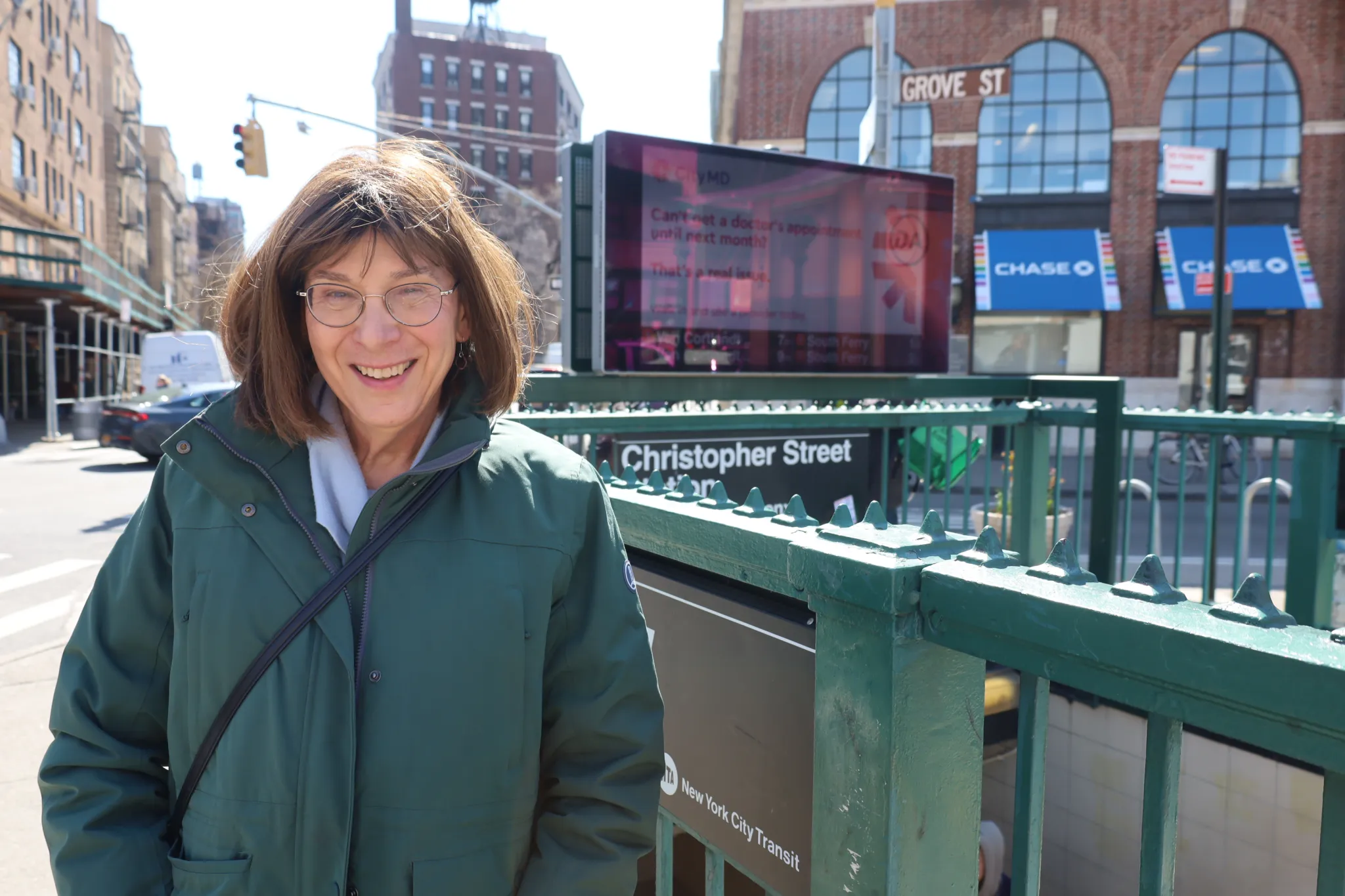
Photo ET Rodriguez
This Sunday, March 31 marks the 16th annual International Transgender Day of Visibility. In celebration, New York City Transit, NYC LGBT Historic Sites Project and the Callen-Lorde Community Health Center joined forces to create a new awareness campaign: “InTransit: Guiding 2.4 million daily riders to respect trans people.”
The initiative will run for a week at the Christopher Street-Sheridan Square train station and features posters directing riders to intransit.nyc. Once on the site, straphangers can learn about trans people in the Big Apple dating back to the 17th Century via the fictitious “T Line.”
The project highlights the stories of 17 NYC landmarks throughout trans history, like the Stonewall monument in Christopher Park and the drag balls at the Imperial Lodge of Elks in Harlem.
“Trans stories existed way before this has become the issue du jour,” said Ken Lustbader, co-director of the NYC LGBT historic sites project. “New York City has been a melting pot of trans lives and we’ve documented that, so there’s no way that that history can be erased.”
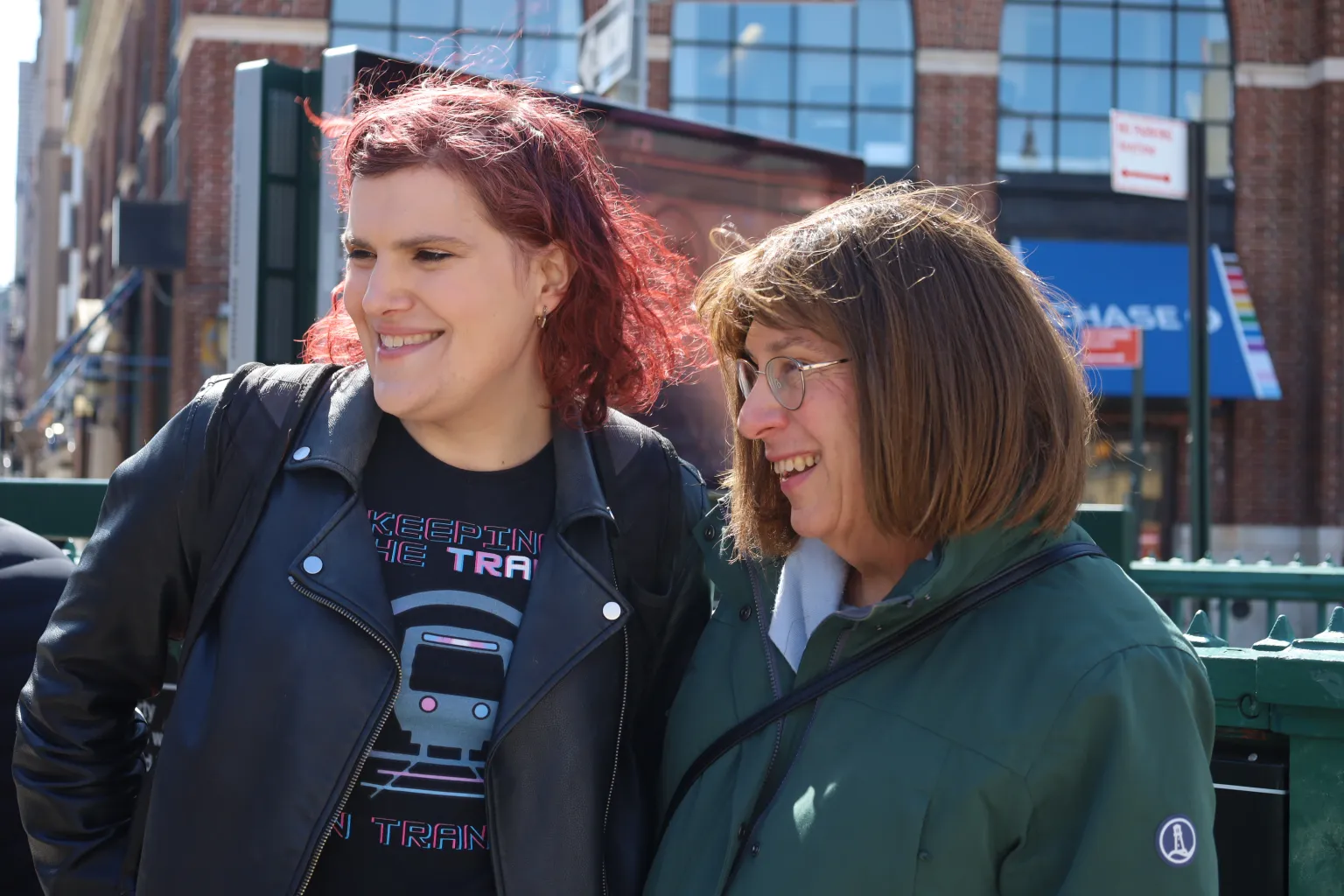
Photo ET Rodriguez
Riders can also tune in to the new podcast mini-series, “InTransit” hosted by the “voice of the subway,” Bernie Wagenblast. The name may not ring a bell, but the voice will as Wagenblast is better known from her booming and ominous announcements warning people to “please stand away from the platform edge.”
Wagenblast came out as transgender on Jan. 1, 2023 and sits down with several guests on the seven-episode podcast to discuss issues trans people face as well as where they can find resources to live happy and healthy lives.
“Visibility is so important because when people see someone that’s different, they come to understand the person — not some stereotype,” Wagenblast told amNewYork Metro. “Hopefully I can increase that visibility.”
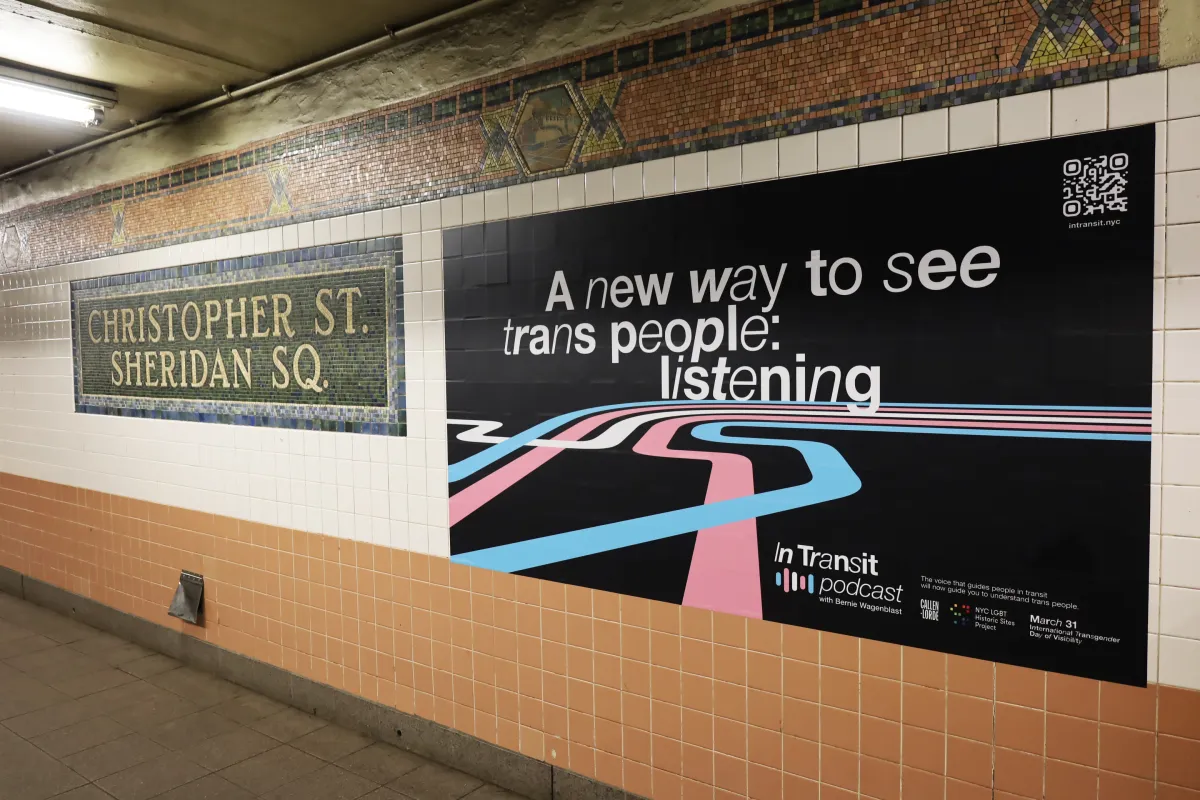
Photo ET Rodriguez
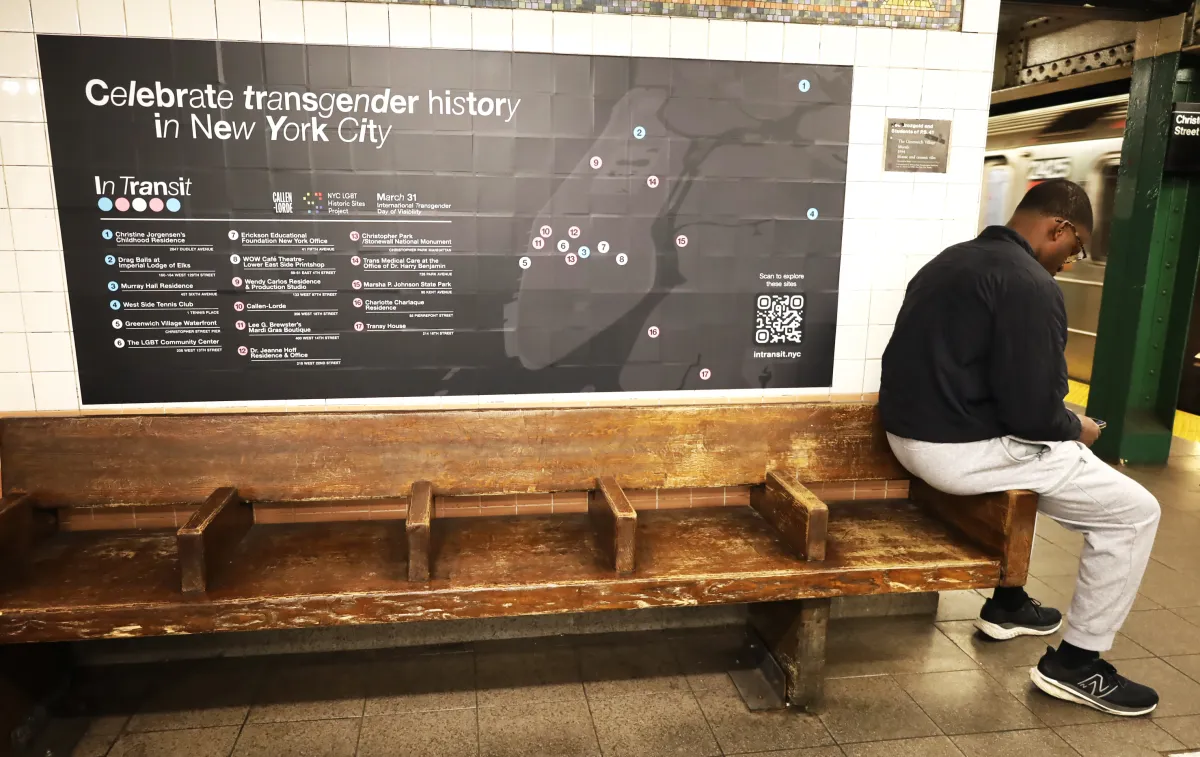
Photo ET Rodriguez
According to the Human Rights Campaign (HRC), 2023 set a record with more than 500 anti-LGBTQ+ bills introduced across the country ranging from banning trans students the right to participate in school sports to banning adults from using restrooms that coincide with their gender identity and scores of anti-LGBTQ+ bills were signed into law. As a result, the HRC declared a national state of emergency for the LGBTQ+ community. But the damage didn’t end there as trans people continue to be the target of hate crimes that turn fatal.
“It’s kind of hard to believe,” said Patrick McGovern, CEO of Callen-Lorde, the leading healthcare provider targeting trans people in NYC. “But we’re seeing similar trends in reproductive rights. We’re losing ground in ways that I don’t think any of us would have thought possible even a few years ago.”
However, McGovern also recognized New York State’s leadership on protecting access to health and ensuring that the state remains a safe haven for the entire LGBTQ+ community.
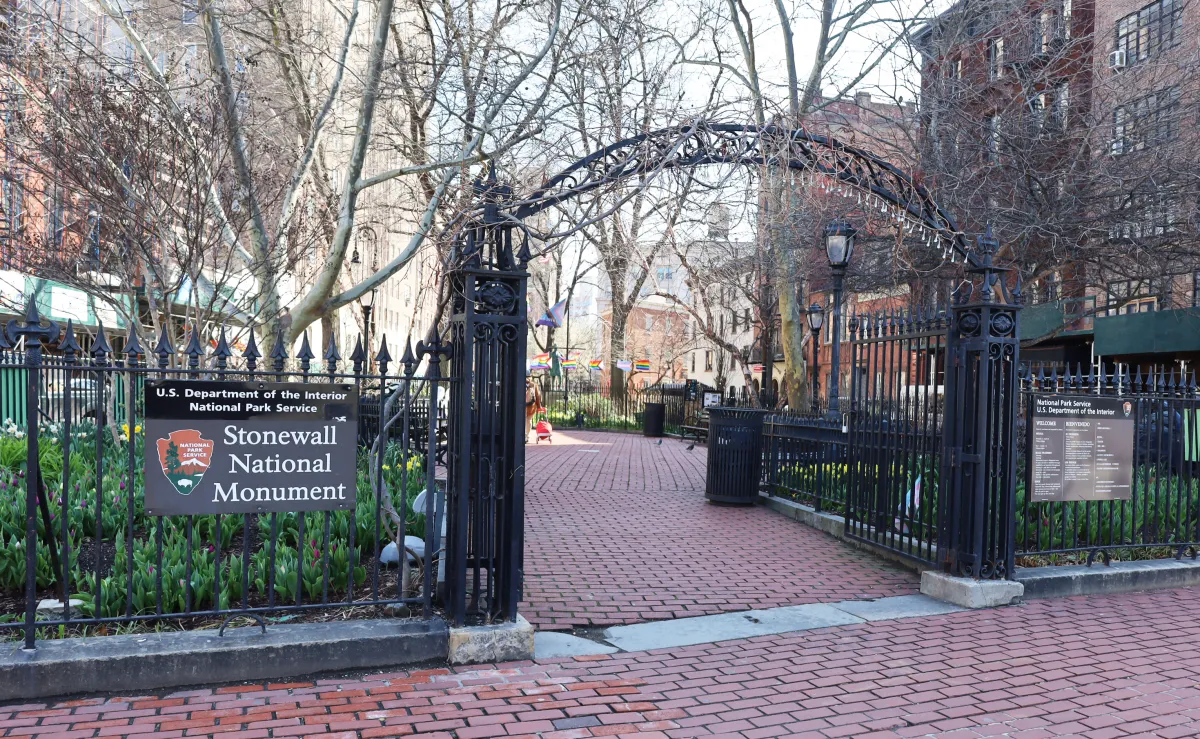
Photo ET Rodriguez
Established in 2009, International Transgender Day of Visibility started to grow legs when Rachel Crandall Crocker was fired from her job as a psychotherapist and lost her marriage after she came out as trans in 1997. But from the ashes rose a phoenix.
“My work wasn’t aware that they were creating a worldwide activist,” Crocker told amNewYork Metro. “If I wasn’t discriminated against so much, I don’t think I ever would have created all the things I did.”
That same year, Crocker co-founded Transgender Michigan, an organization dedicated to providing mental health and resources to trans people. She continued with her activism, but it was the advent of Facebook that helped give her cause a platform when she created a group calling for recognition of transgender people. It took some time to gain traction, but with Crocker’s perseverance, she soon had activists and leaders from around the world reaching out and wanting to join in her effort.
“I wanted a day that we could celebrate being alive,” said Crocker. “The only day we had was the [Transgender] Day of Remembrance [established in 1999] which is when we remembered those who were killed just from being trans.”
Help bring awareness and visibility to the transgender community by visiting intransit.nyc where you can listen to the stories you didn’t know you didn’t know.
And Rachel Crandall Crocker wants to remind everyone, “you don’t have to be perfect to change the world – you just have to be you.”
Bernie Wagenblast, out trans ‘voice of the subway,’ rolls out podcast and visibility campaign
March 29, 2024
By: Donna Aceto & Matt Tracy
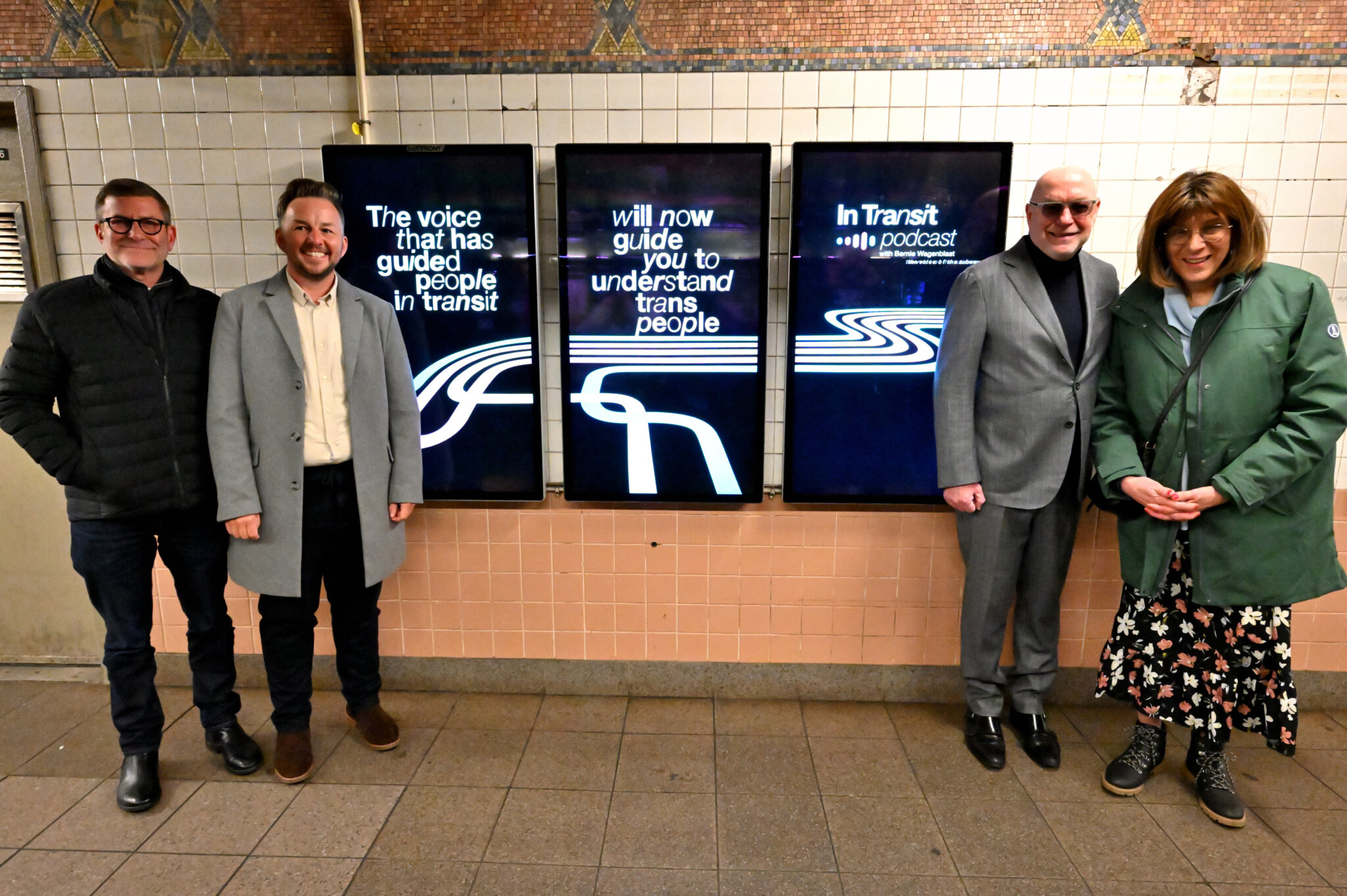
DONNA ACETO
Millions of subway riders have heard Bernie Wagenblast’s voice, but only a small fraction of straphangers know who she is. That’s all about to change!
Wagenblast, who is known as the “voice of the subway” and came out as transgender last year, is stepping into the spotlight for a new transgender awareness campaign that will feature a podcast mini-series, hosted by Wagenblast herself, called “InTransit.”
Up Next – RELATED NEWS: – Roundup of Transgender Day of Visibility events in NYC
The new campaign was announced on March 29 — just in time for International Transgender Day of Visibility on March 31 — at the Christopher Street-Sheridan Square subway station, where the installation includes posters and digital billboards to spread trans-inclusive messages and inform riders about the forthcoming podcast. The podcast — which already has two episodes on Spotify — aims to educate members of the public about gender identity, appropriate language, and more.
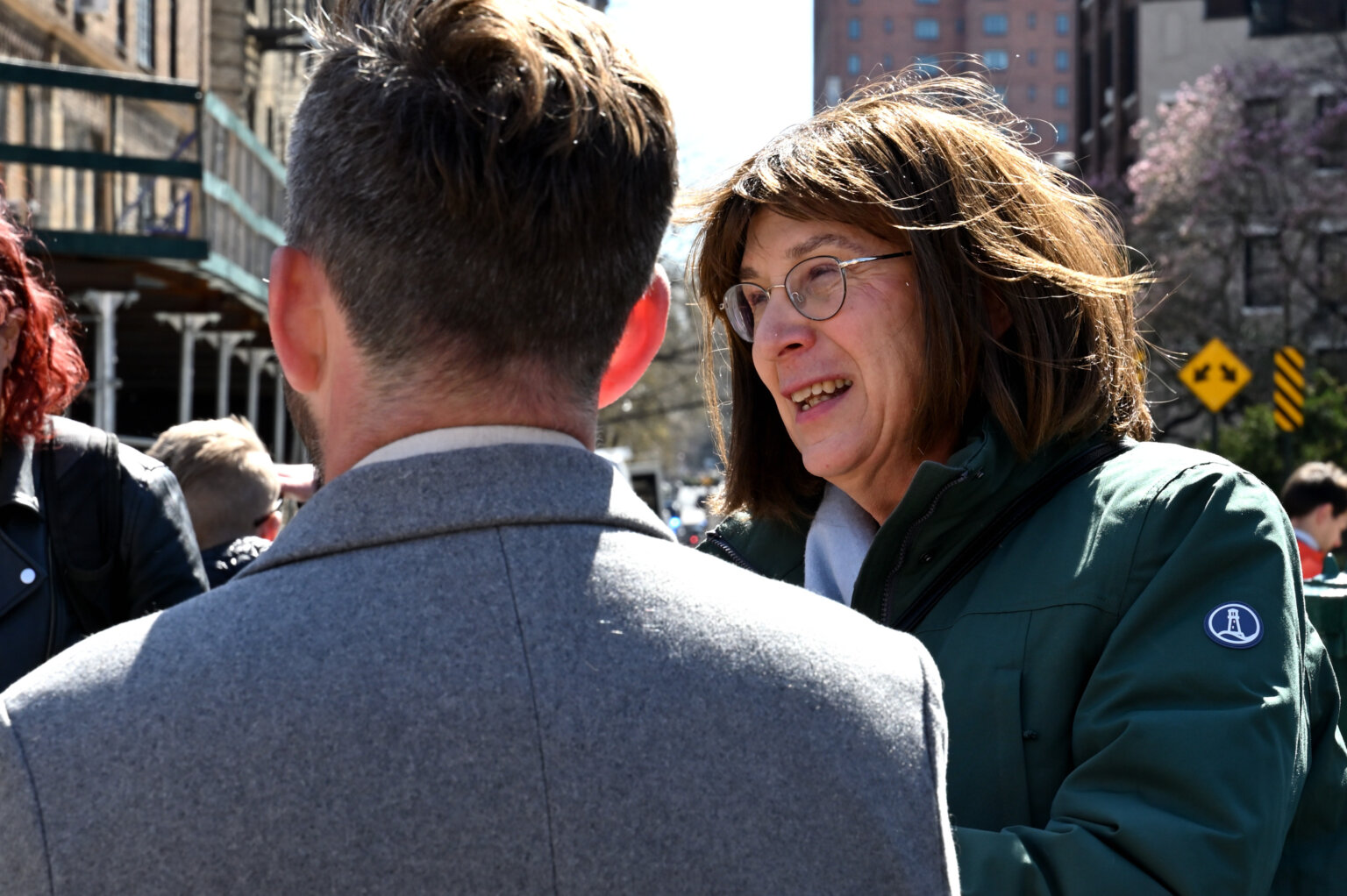
DONNA ACETO
Wagenblast joined stakeholders at the Christopher Street-Sheridan Square station on March 29 to roll out the campaign. AREA 23, a healthcare marketing agency, created the campaign with support from Callen-Lorde Community Health Center and the NYC LGBT Historic Sites Project.
“I know how much visibility matters and I hope, by sharing my story, folks will be reminded that transgender people are a part of their everyday life each time they hear me making an announcement,” Wagenblast said in a written statement announcing the new campaign.
As for the campaign itself, it is hard to miss for any rider passing through the station. In one area of the station, back-to-back-to-back digital screens perched on the wall combine into one animation that reads, “The voice that has guided people in transit will now guide you to understand trans people,” followed by a promotional message previewing the podcast.
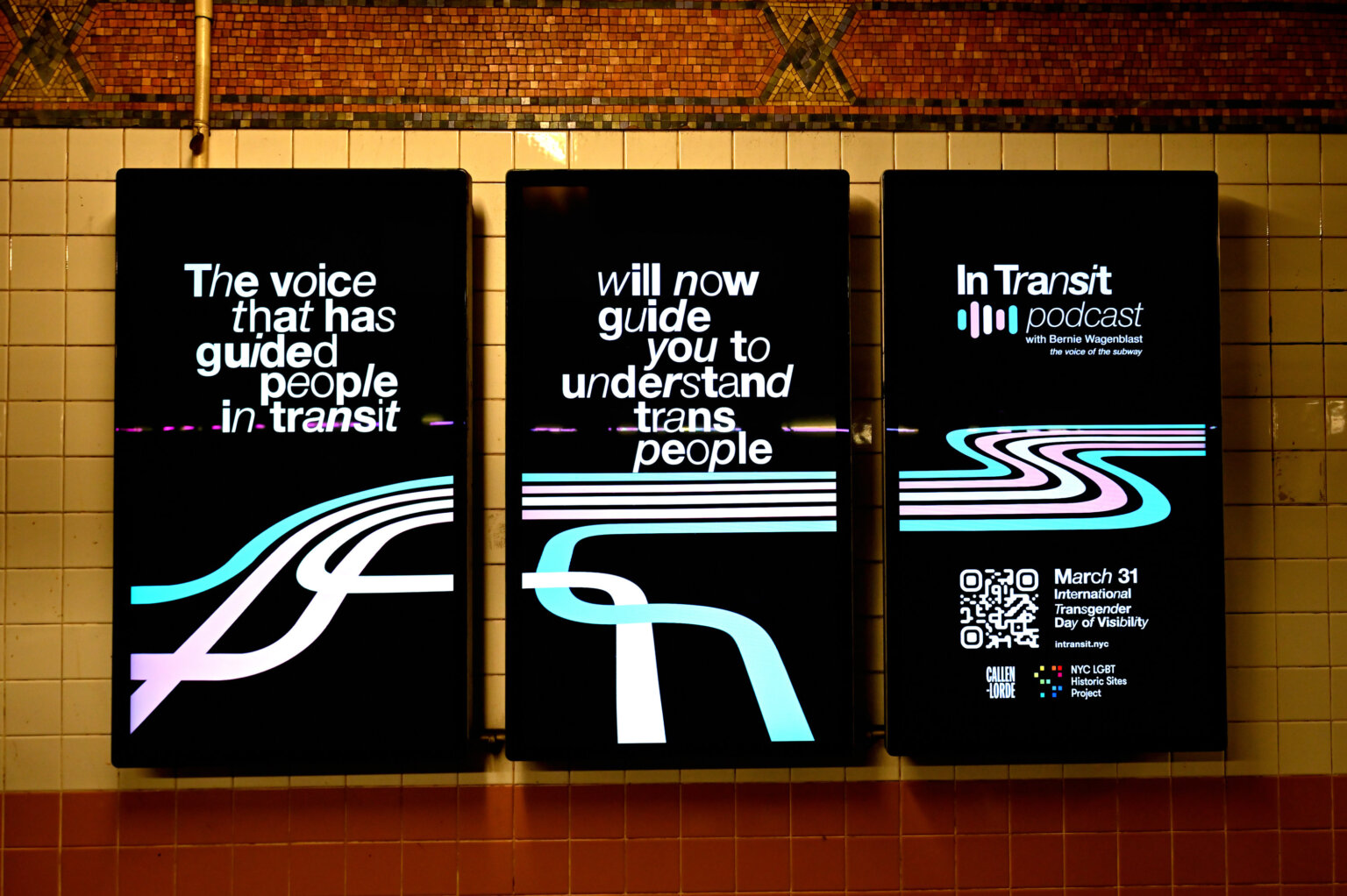
DONNA ACETO
The station also has a billboard painted on the wall, stating, “A new way to see trans people: listening.” The bottom corner of the ad showcases the logo for the podcast, while the top corner features a QR code for easy digital access.
“This is an opportunity to share Bernie’s story as a way to help raise visibility for transgender people and celebrate their contributions and milestones while also raising awareness for the discrimination that many face around the globe,” David Taini, the group creative director at Area 23, said in a written statement.
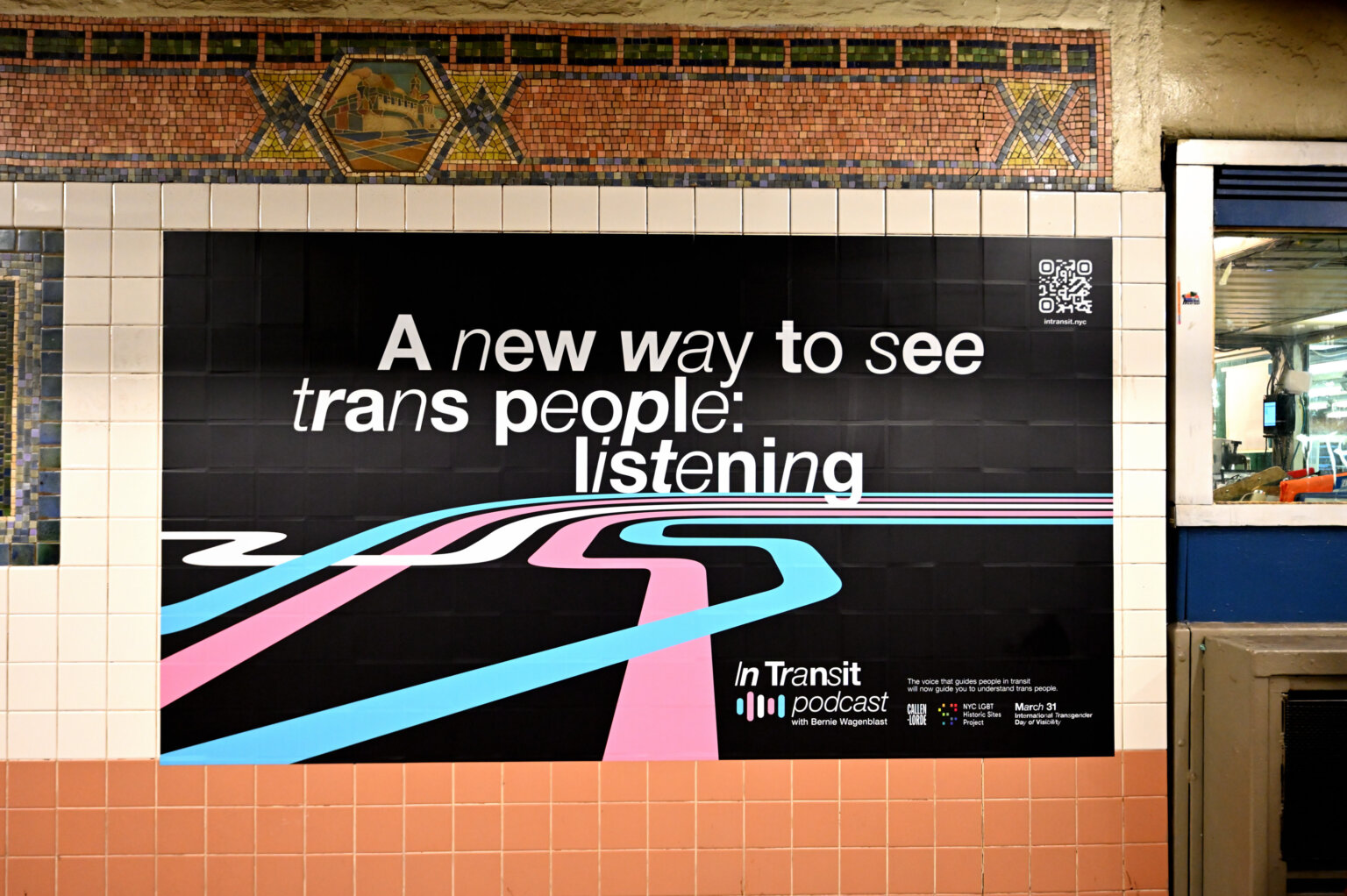
DONNA ACETO
Ken Lustbader, who is the co-director of the NYC LGBT Historic Sites Project, acknowledged that the announcement coincided with International Transgender Day of Visibility.
“As we recognize Transgender Day of Visibility, it’s crucial to also understand that trans people have always existed, making their own history as they pursue healthy, safe, and joyful lives,” Lustbader said in a written statement. “‘In Transit’ and the T Line have the power to introduce large numbers of New Yorkers to place-based trans history, right here in their own city. From the 19th century residence of Murray Hall to medical offices where ground-breaking care was provided as early as the 1940s, these extant sites allow for a visceral connection to an often overlooked history.”
Patrick McGovern, the CEO of Callen-Lorde Community Health Center, stressed the importance of the visibility campaign in the face of transphobia across the country.
“The resilience of the trans community has paved the way for LGBTQ+ rights across the country, and their stories deserve to be amplified and celebrated,” McGovern said. “At a time when LGBTQ+ healthcare is under attack, Callen-Lorde is proud to serve as a safe haven for queer and trans people who need knowledgeable and welcoming healthcare–as we have for more than 55 years.”
NY Statewide Preservation Conference
April 16, 2024 | 11:15 AM
Memorial Art Gallery, 500 University Ave, Rochester, NY 14607
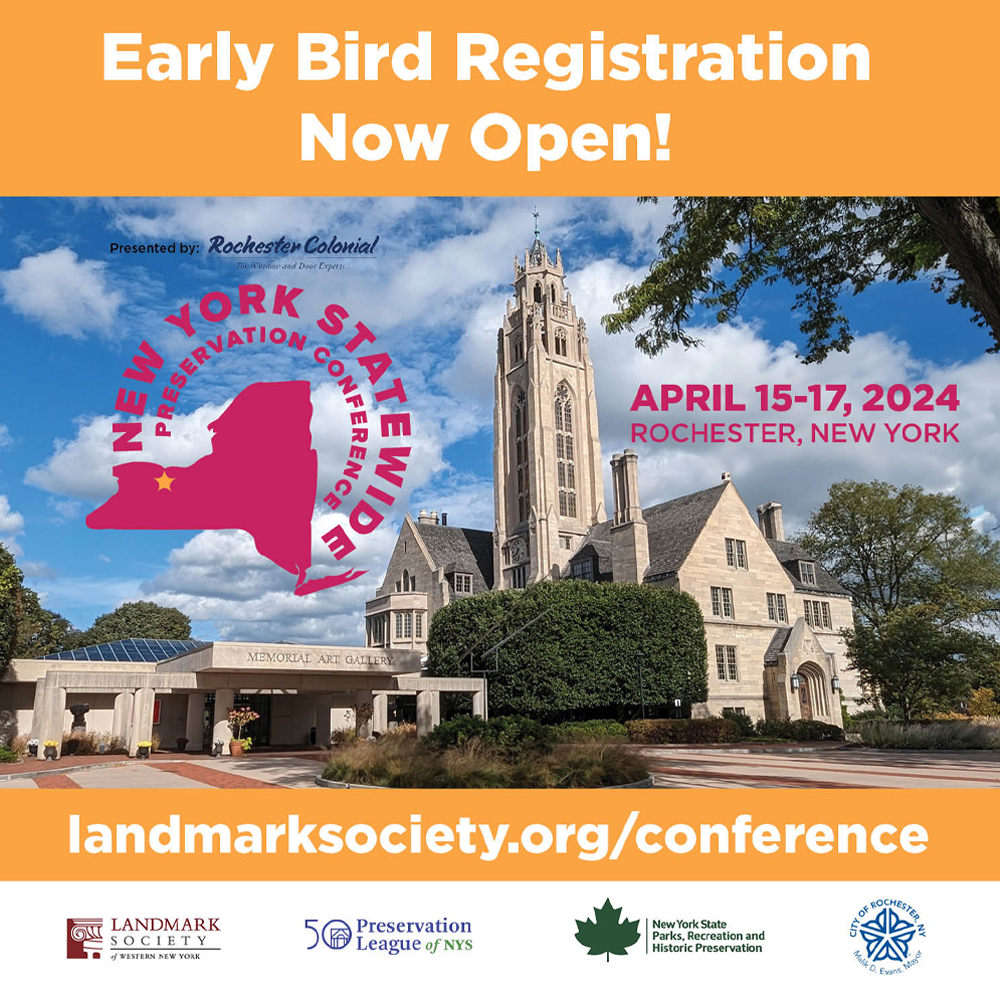 The NY Statewide Preservation Conference is returning to Rochester, and General Registration is now open (through April 5 or while space remains)! Featuring three days of exploration, conversation, and education. It is the only event of its kind in the state—a multi-day gathering for anyone involved in preservation and community revitalization.
The NY Statewide Preservation Conference is returning to Rochester, and General Registration is now open (through April 5 or while space remains)! Featuring three days of exploration, conversation, and education. It is the only event of its kind in the state—a multi-day gathering for anyone involved in preservation and community revitalization.
Project manager Amanda Davis will participate on April 16th at 11:15am on a panel moderated by Dr. Jeff Iovannone.
Panel: LGBTQ Heritage Conservation in New York State: Perspectives, Strategies, Challenges
Speakers
Dr. Jeff Iovannone | Preservation Planner, Landmark Society of Western New York
Dr. Samantha Rosenthal | Associate Professor of History, Roanoke College; Co-founder, Southwest Virginia LGBTQ+ History Project
Erin Tobin | Executive Director, Adirondack Architectural Heritage
Amanda Davis | Project Manager, NYC LGBT Historic Sites Project
CLICK HERE TO REGISTER
Awareness Campaign to Take Over Christopher Street Station for International Transgender Day of Visibility
March 26, 2024
PRESS CONTACT
Ken Lustbader, NYC LGBT Historic Sites Project
(917) 848-1776 / [email protected]
Awareness Campaign to Take Over Christopher Street Station for International Transgender Day of Visibility
‘Voice of the Subway’ Bernie Wagenblast hosts limited-series podcast featuring Callen-Lorde, NYC LGBT Historic Sites Project and other notables
Media Availability Planned for Friday, March 29 at 11:00 AM
NEW YORK (March 26, 2024)—A new awareness campaign, “In Transit: Guiding 2.4 million daily riders to respect trans people,” will launch at the Christopher Street-Sheridan Square station on Friday, March 29 in honor of International Transgender Day of Visibility. The campaign is inspired by ‘Voice of the Subway’ Bernie Wagenblast who came out as transgender in 2022, and her voice will be heard in the subway station in recognition of this day.
The campaign was created by AREA 23, an IPG Health company and award-winning healthcare marketing agency, with expert support from the NYC LGBT Historic Sites Project, an award-winning cultural heritage initiative, and Callen-Lorde Community Health Center, a global leader in LGBTQ+ health.
The installation features posters in the Christopher Street station, a location with deep significance to the community, that raise awareness of Transgender Day of Visibility and drive riders to listen to a podcast mini-series, “InTransit,” hosted by Bernie Wagenblast and includes rotating guests. Each episode is the length of a typical subway ride and will highlight educational content related to the transgender community including gender identity, inclusive language and other relevant topics. In addition, the campaign will lead to the unveiling of a new fictional transit line in which every stop represents a real-life landmark of the trans movement in New York City. People will be able to “ride” the line via a forthcoming microsite traveling through a sampling of NYC’s trans history.
Bernie Wagenblast, Voice of the Subway:
“I know how much visibility matters and I hope, by sharing my story, folks will be reminded that transgender people are a part of their everyday life each time they hear me making an announcement.”
David Traini, Group Creative Director, AREA 23:
“This is an opportunity to share Bernie’s story as a way to help raise visibility for transgender people, celebrate their contributions and milestones while also raising awareness for the discrimination that many face around the globe. Our goal was twofold: to spotlight and support the transgender community while also fostering understanding and education among all commuters.”
Ken Lustbader, co-director of the NYC LGBT Historic Sites Project:
“As we recognize Transgender Day of Visibility, it’s crucial to also understand that trans people have always existed, making their own history as they pursue healthy, safe, and joyful lives. ‘In Transit’ and the T Line have the power to introduce large numbers of New Yorkers to place-based trans history, right here in their own city. From the 19th century residence of Murray Hall to medical offices where ground-breaking care was provided as early as the 1940s, these extant sites allow for a visceral connection to an often overlooked history.”
Patrick McGovern, CEO of Callen-Lorde:
“We’re honored to be part of this creative and engaging campaign that uplifts the experiences of trans New Yorkers for International Transgender Day of Visibility,” said Patrick McGovern, CEO of Callen-Lorde Community Health Center. “The resilience of the trans community has paved the way for LGBTQ+ rights across the country, and their stories deserve to be amplified and celebrated. At a time when LGBTQ+ healthcare is under attack, Callen-Lorde is proud to serve as a safe haven for queer and trans people who need knowledgeable and welcoming healthcare–as we have for more than 55 years.”
For more information please contact: [email protected] and [email protected].
About NYC LGBT Historic Sites Project
The NYC LGBT Historic Sites Project, launched in 2015 by preservation professionals, is an award-winning cultural heritage initiative and educational resource documenting and presenting historic sites connected to the LGBTQ+ community throughout New York City. Its website, including an interactive map, features over 450 diverse places from the 17th century to 2000 that are important to LGBTQ+ history and illustrate the community’s influence on NYC and American culture. The project researches and nominates LGBTQ+ sites to the National Register of Historic Places, advocates for local recognition of LGBTQ+ historic sites, conducts public programs, and disseminates its content through robust social media channels (@nyclgbtsites). Its goal is to make an invisible history visible while fostering pride and awareness.
About Callen-Lorde
Callen-Lorde is the global leader in LGBTQ+ health care. Since the days of Stonewall, we have been transforming lives in LGBTQ+ communities through excellent comprehensive care, provided free of judgment and regardless of ability to pay. In addition, we continuously pioneering research, advocacy and education to drive positive change for LGBTQ+ people, because we believe health care is a human right. To learn more about Callen-Lorde, please visit callen-lorde.org
About AREA 23, An IPG Health Company
Part of the IPG Health network, AREA 23 is a full-service agency focused on pushing creativity and invention in healthcare marketing to new heights. Its “What If” way of working provides a framework for breakthrough ideas that truly drive innovation and keep clients ahead of industry trends. AREA 23 has been consistently recognized with the highest industry awards and honors including three Grands Prix at Cannes Lions and “Healthcare Agency of the Year” at Cannes Lions in 2020/2021, 2022 and 2023, and “Global Pharma Agency of the Year” and “North American Regional Pharma Agency of the Year” at the 2023 London International Awards. The agency was also recognized as the #1 most creative agency in the world on The Drum’s 2023 World Creative Rankings – the first time a healthcare agency has secured the top spot in the U.S. and global leaderboards. Visit area23hc.com to learn more.
Impressions of Great Establishments of Greenwich Village
April 16, 2024 | 6:00 PM
Jefferson Market Library, 425 Avenue of the Americas
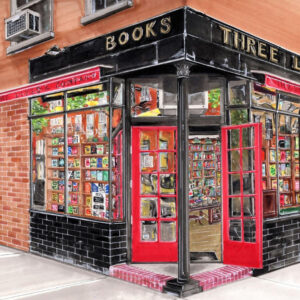 Since the early 20th century, Greenwich Village has been a sanctuary for writers, artists, academics, and activists alike. As the century progressed, the charming tree-lined streets bore witness to the collection of quintessential theaters, bookstores, cabarets, jazz clubs, and iconic monuments that have contributed to New York City and American culture.
Since the early 20th century, Greenwich Village has been a sanctuary for writers, artists, academics, and activists alike. As the century progressed, the charming tree-lined streets bore witness to the collection of quintessential theaters, bookstores, cabarets, jazz clubs, and iconic monuments that have contributed to New York City and American culture.
Documenting these historic sites through illustrations has the ability to create an archival record of the past. Please join us to discuss the contemporary work of artist Lily Annabelle who has illustrated many of these important sites as part of an exhibition opening at Jefferson Market Library on April 3.
Speakers from Village Preservation and the NYC LGBT Historic Sites Project will share with the community the Village’s past and present, with highlights on music, theater, literature, and LGBTQ histories.
Some highlighted sites include –
- The Public Theatre
- Café Wha?
- Three Lives & Co.
- Cherry Lane Theatre
- IFC
- Julius
- Gay Activists Alliance Firehouse
- Cubbyhole
- The Stonewall Inn
- Oscar Wilde Memorial Bookshop
About the Artist: Lily Annabelle is a West Village-based illustration artist. Prior to starting her art career in April 2023, Lily worked as a data analytics professional, holding a leadership position at a market research company. Despite being new to the art scene, Lily already started to gain ground in the city. Her illustrations are proudly treasured by over 50 famed New York establishments, among them are familiar names such as Bergdorf Goodman, Smith & Wollensky, and Comedy Cellar. Currently, Lily is preparing to publish her first book.
Use of library space for this program does not indicate endorsement by The New York Public Library.
CLICK HERE TO REGISTER
BOOK TALK: “GETTING IN: NYC Club Flyers from the Gay 1990s”
March 12, 2024 | 6:30 PM - 8 PM
Zoom (virtual)

The Roxy, Splash, Disco 2000, MEAT, Pyramid, Limelight … take a visual tour through the dizzying rise and demise of these legendary queer NYC clubs and parties with journalist and historian David Kennerley as he discusses his new book, GETTING IN: NYC Club Flyers from the Gay 1990s. Revisit dozens of bars, dance clubs, sex clubs, and other nightlife venues that provided a refuge during the AIDS crisis through eye-popping flyers from Kennerley’s collection.
The event will be hosted by Ken Lustbader, co-director of the NYC LGBT Historic Sites Project, who will highlight nightlife spots from the pre- and post-Stonewall period.
About the Speaker
David Kennerley is a journalist and historian specializing in LGBTQ culture. For two decades, he has been an Arts & Entertainment reporter for Gay City News. Examples from his ephemera collection were shown in the “Letting Loose and Fighting Back” exhibition at the New-York Historical Society honoring the 50th anniversary of the Stonewall uprising. He currently lives in the West Village neighborhood of Manhattan and occasionally still goes clubbing. His latest publication is GETTING IN: NYC Club Flyers from the Gay 1990s. (buy here)
About the NYC LGBT Historic Site Project
The NYC LGBT Historic Sites Project is a nonprofit cultural initiative and educational resource that is making an invisible history visible by documenting extant historic and cultural sites associated with the LGBT community throughout New York City. For more, visit www.nyclgbtsites.org, or follow on Instagram, Facebook, or Twitter.
This event is funded, in part, by grants from Consolidated Edison, New York Community Trust, New York State Council on the Arts with the support of the Office of the Governor and the New York State Legislature, and New York City Tourism Foundation.
CLICK HERE TO REGISTER
Steve Ostrow, who founded famed NYC bathhouse the Continental Baths, dies at 91
February 13, 2024
By: Associated Press

NEW YORK (AP) — Steve Ostrow, who founded the trailblazing New York City gay bathhouse the Continental Baths, where Bette Midler, Barry Manilow and other famous artists launched their careers, has died. He was 91.
The Brooklyn native died Feb. 4 in his adopted home of Sydney, Australia, according to an obituary in The Sydney Morning Herald.
“Steve’s story is an inspiration to all creators and a celebration of New York City and its denizens,” Toby Usnik, a friend and spokesperson at the British Consulate General in New York, posted on X.
Ostrow opened the Continental Baths in 1968 in the basement of the Ansonia Hotel, a once grand Beaux Arts landmark on Manhattan’s Upper West Side that had fallen on hard times.
He transformed the hotel’s massive basement, with its dilapidated pools and Turkish baths, into an opulently decorated, Roman-themed bathhouse.
The multi-level venue was not just an incubator for a music and dance revolution deeply rooted in New York City’s gay scene, but also for the LGBTQ community’s broader political and social awakening, which would culminate with the Stonewall protests in lower Manhattan, said Ken Lustbader of the NYC LGBT Historic Sites Project, a group that researches places of historic importance to the city’s LGBTQ community.
“Steve identified a need,” he said. “Bathhouses in the late 1960s were more rundown and ragged, and he said, ‘Why don’t I open something that is going to be clean, new and sparkle, where I could attract a whole new clientele’?”
Privately-run bathhouses proliferated in the 1970s, offering a haven for gay and bisexual men to meet during a time when laws prevented same-sex couples from even dancing together. When AIDS emerged in the 1980s, though, bathhouses were blamed for helping spread the disease and were forced to close or shuttered voluntarily.
The Continental Baths initially featured a disco floor, a pool with a waterfall, sauna rooms and private rooms, according to NYC LGBT Historic Sites’ website.
As its popularity soared, Ostrow added a cabaret stage, labyrinth, restaurant, bar, gym, travel desk and medical clinic. There was even a sun deck on the hotel’s rooftop complete with imported beach sand and cabanas.
Lustbader said at its peak, the Continental Baths was open 24 hours a day and seven days a week, with some 10,000 people visiting its roughly 400 rooms each week.
“It was quite the establishment,” he said. “People would check in on Friday night and not leave until Sunday.”
The Continental Baths also became a destination for groundbreaking music, with its DJs shaping the dance sounds that would become staples of pop culture.
A young Bette Midler performed on the poolside stage with a then-unknown Barry Manilow accompanying her on piano, cementing her status as an LGBTQ icon.
But as its musical reputation drew a wider, more mainstream audience, the club’s popularity among the gay community waned, and it closed its doors in 1976. The following year, Plato’s Retreat, a swinger’s club catering to heterosexual couples, opened in the basement space.
Ostrow moved to Australia in the 1980s, where he served as director of the Sydney Academy of Vocal Arts, according to his obituary. He also founded Mature Age Gays, a social group for older members of Australia’s LGBTQ community.
“We are very grateful for the legacy of MAG that Steve left us,” Steve Warren, the group’s president, wrote in a post on its website. “Steve’s loss will leave a big hole in our heart but he will never be forgotten.”
Steve Ostrow, who founded famed NYC bathhouse the Continental Baths, dies at 91
February 12, 2024
By: Philip Marcelo
NEW YORK (AP) — Steve Ostrow, who founded the trailblazing New York City gay bathhouse the Continental Baths, where Bette Midler, Barry Manilow and other famous artists launched their careers, has died. He was 91.
The Brooklyn native died Feb. 4 in his adopted home of Sydney, Australia, according to an obituary in The Sydney Morning Herald.
“Steve’s story is an inspiration to all creators and a celebration of New York City and its denizens,” Toby Usnik, a friend and spokesperson at the British Consulate General in New York, posted on X.
Ostrow opened the Continental Baths in 1968 in the basement of the Ansonia Hotel, a once grand Beaux Arts landmark on Manhattan’s Upper West Side that had fallen on hard times.
He transformed the hotel’s massive basement, with its dilapidated pools and Turkish baths, into an opulently decorated, Roman-themed bathhouse.
The multi-level venue was not just an incubator for a music and dance revolution deeply rooted in New York City’s gay scene, but also for the LGBTQ community’s broader political and social awakening, which would culminate with the Stonewall protests in lower Manhattan, said Ken Lustbader of the NYC LGBT Historic Sites Project, a group that researches places of historic importance to the city’s LGBTQ community.
“Steve identified a need,” he said. “Bathhouses in the late 1960s were more rundown and ragged, and he said, ‘Why don’t I open something that is going to be clean, new and sparkle, where I could attract a whole new clientele’?”
Privately-run bathhouses proliferated in the 1970s, offering a haven for gay and bisexual men to meet during a time when laws prevented same-sex couples from even dancing together. When AIDS emerged in the 1980s, though, bathhouses were blamed for helping spread the disease and were forced to close or shuttered voluntarily.
The Continental Baths initially featured a disco floor, a pool with a waterfall, sauna rooms and private rooms, according to NYC LGBT Historic Sites’ website.
As its popularity soared, Ostrow added a cabaret stage, labyrinth, restaurant, bar, gym, travel desk and medical clinic. There was even a sun deck on the hotel’s rooftop complete with imported beach sand and cabanas.
Lustbader said at its peak, the Continental Baths was open 24 hours a day and seven days a week, with some 10,000 people visiting its roughly 400 rooms each week.
“It was quite the establishment,” he said. “People would check in on Friday night and not leave until Sunday.”
The Continental Baths also became a destination for groundbreaking music, with its DJs shaping the dance sounds that would become staples of pop culture.
A young Bette Midler performed on the poolside stage with a then-unknown Barry Manilow accompanying her on piano, cementing her status as an LGBTQ icon.
But as its musical reputation drew a wider, more mainstream audience, the club’s popularity among the gay community waned, and it closed its doors in 1976. The following year, Plato’s Retreat, a swinger’s club catering to heterosexual couples, opened in the basement space.
Ostrow moved to Australia in the 1980s, where he served as director of the Sydney Academy of Vocal Arts, according to his obituary. He also founded Mature Age Gays, a social group for older members of Australia’s LGBTQ community.
“We are very grateful for the legacy of MAG that Steve left us,” Steve Warren, the group’s president, wrote in a post on its website. “Steve’s loss will leave a big hole in our heart but he will never be forgotten.”
Dozens of NYC’s LGBTQ historic sites in the spotlight for Black History Month
February 2, 2024
By: Matt Tracy
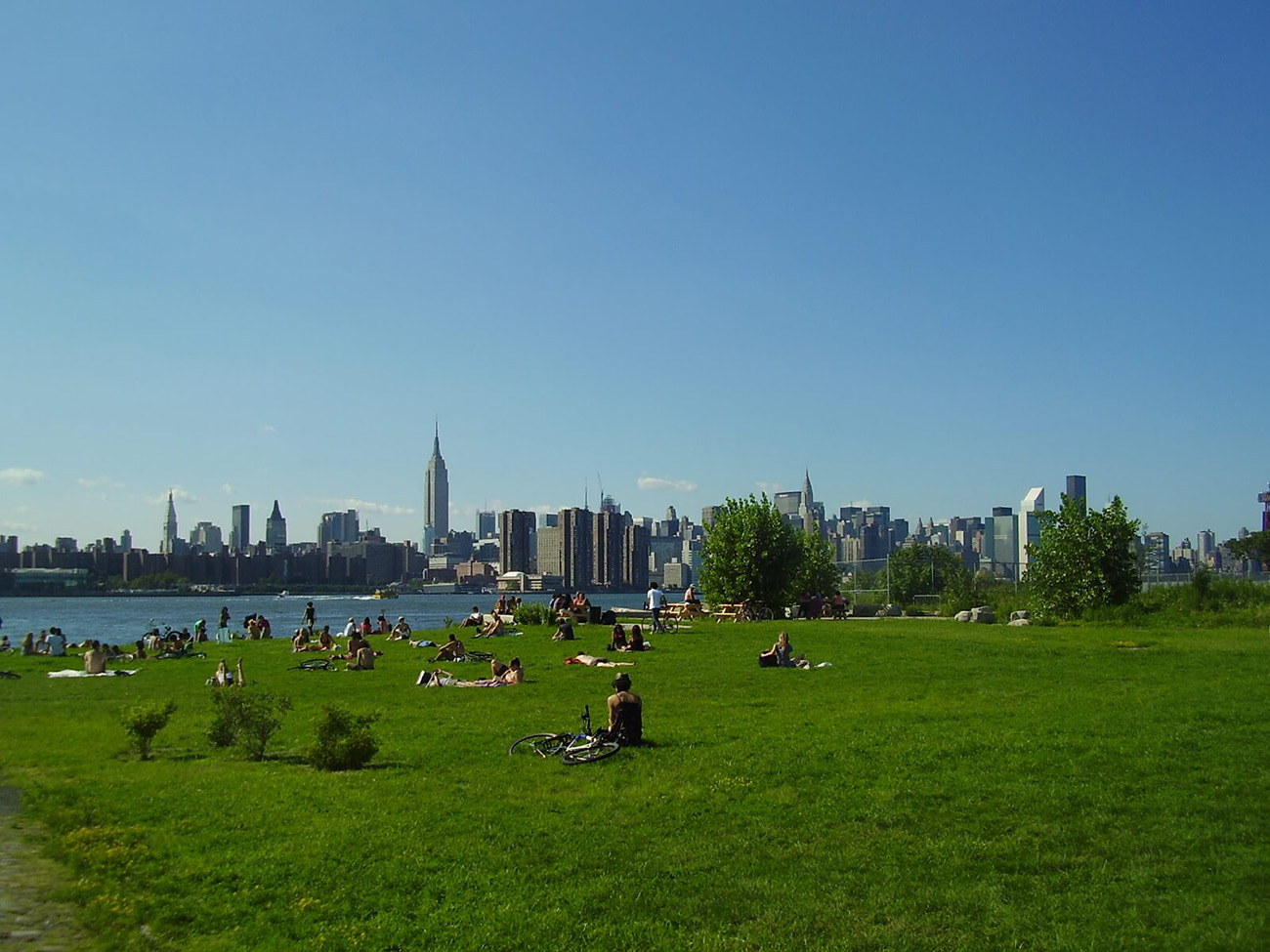
WIKIMEDIA COMMONS / MMZACH
Dozens of New York City locations are being highlighted this month as part of a collection commemorating Black History Month — including spots ranging from the late Audre Lorde’s residence to the Mt. Morris Baths, which was a popular bathhouse among gay Black men beginning in the 1920s until it closed in 2003.
The collection is one of the latest works of the NYC LGBT Historic Sites Project, which is part of the non-profit Fund for the City of New York and has long focused on spotlighting the history surrounding important physical locations in the city’s queer community.
Many of the 48 locations have changed in appearance or structure over the years, but the vast majority of the ones included in the collection are still standing. Just two of them — Paradise Garage, a former club at 84 King St., and Hotel Olga at 695 Lenox Ave. in Harlem — have been demolished.
The locations are scattered across the city in every borough except Queens. Some of the most notable places on the list include James Baldwin’s residence at 137 W. 71st St., where he lived for the last two decades of his life, and Marsha P. Johnson State Park — which just opened in 2020 — at 90 Kent Ave. in Brooklyn. But there are also spaces that are well known among New Yorkers, such as the Apollo Theater at 253 W. 125th St. in Harlem and Bellevue Hospital at 462 First Ave. in the Kips Bay section of Manhattan, where the late Marsha P. Johnson was once pictured at a Gay Liberation Front demonstration calling out the hospital’s abusive treatments and experimentations on LGBTQ people.
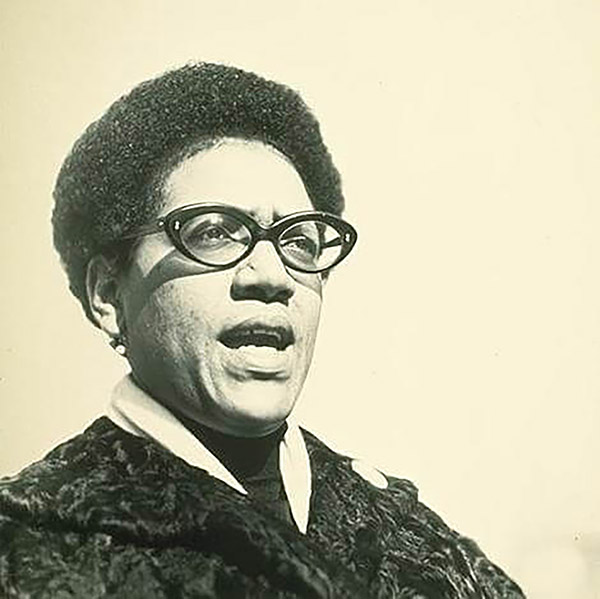
WIKIMEDIA COMMONS / ELSA DORFMAN
Other spots include the location where Ali Forney was killed at the corner of E. 135th St. and Fifth Ave. in 1997. Forney was a gender non-conforming young person who struggled with homelessness, and in 2002, the Ali Forney Center — which provides housing and services to homeless queer youth — was named after them.
Some of the rather unassuming historic locations are the residences that blend in with the local neighborhoods, such as the former home of Pauli Murray, a Black civil rights attorney and author who was in a long-term relationship with Irene “Renee” Barlow and lived at 388 Chauncey St. in Brooklyn in what appeared to be a three-story home. Other inconspicuous locations include the former home of civil rights leader Bayard Rustin, who lived in an apartment at Building 7, Penn South in the Chelsea section of Manhattan from 1962 until he died in 1987. His residence is also on the New York State Register of Historic Places and National Register of Historic Places.
Back uptown, some other buildings on the list include the one at 160-164 W. 129th St. in Manhattan, which was home to the Imperial Lodge of Elks, AKA the Elks Lounge, as seen in “Paris Is Burning.” Just blocks away from there was the conveniently-located Mt. Morris Baths, which was one of the longest-running bathhouses in New York City and, according to the LGBT Historic Sites Project, the only gay bathhouse willing to welcome Black men until the 1960s. However, even after health officials cracked down on bathhouses in the mid-80s due to the HIV/AIDS crisis, the Mt. Morris Baths persisted. The bathhouse discouraged public sex and prioritized education about HIV/AIDS, according to the LGBT Historic Sites Project, though it was ultimately closed in 2003 due to structural issues.
Staten Island only has two spots on the list, but they do not disappoint: One is the residence of activist and writer Audre Lorde and her partner Frances Clayton, along with their children, at 207 St. Paul’s Ave.; the other is the former residence of Michelle Cliff, a Jamaican-born author who lived at 45 Belmont Place. Also on the list is the home of the Audre Lorde Project, at 85 South Oxford St. in Brooklyn.
Houses of Worship also have a place on the list. Washington Square United Methodist Church and Parish House, at 135 and 133 W. Fourth St., which was led by out gay reverend Paul Abels in the 1970s and 1980s, doubled up as a meeting venue for LGBTQ groups such as the Salsa Soul Sisters, an early Black lesbian organization which gathered there from 1976 until 1987.
Bars on the list include Café Society/Ridiculous Theatrical Company, which was known as the city’s first integrated club and was located at 1 Sheridan Square; 70 Grove St., where several lesbian bars called home from the 1970s to the 1990s, including Pandora’s Box, which was popular among Black and Latinx lesbians; and Starlite Lounge, which was owned by Harold “Machie” Harris and had a reputation for being the “oldest Black-owned non-discriminating bar in New York,” according to the LGBT Historic Sites Project. Harris purchased the lounge in 1962 and it lasted until 2010 when it was forced to close due to a building sale.
See the complete list of locations and their historic significance — as well as a map pinpointing each spot — at nyclgbtsites.org/theme/black-history-month.
WONDROUS TRANSFORMATIONS: Dr. Harry Benjamin & Transgender Medicine
January 16, 2024 | 6:30 PM - 8 PM
Zoom (virtual)
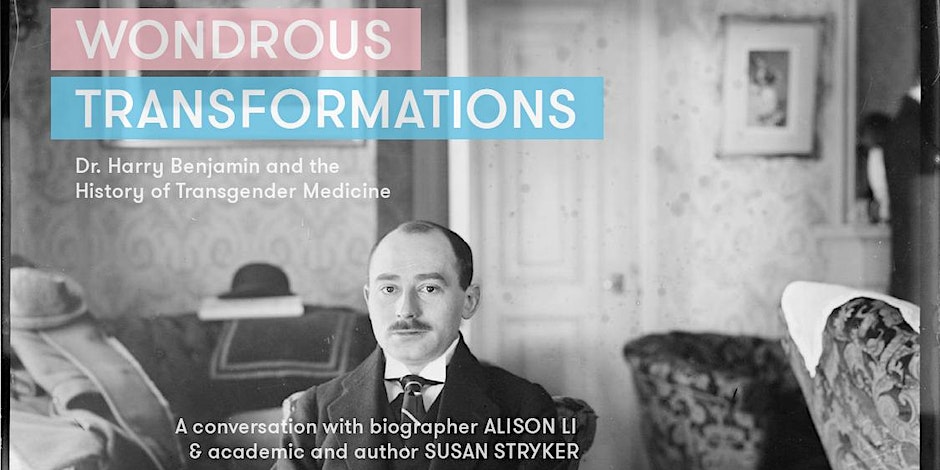
With an introduction on transgender history and medical care by scholar Susan Stryker, this book talk and conversation features Alison Li, author of the newly-published biography, Wondrous Transformations: A Maverick Physician, the Science of Hormones, and the Birth of the Transgender Revolution.
Through the late 1940s, the use of hormone therapy and surgery as medical treatment options for trans individuals was not widely studied, available, or legal in the U.S. This approach changed through the work of Dr. Harry Benjamin, who in 1948, became one of the first physicians in the U.S. to work with transgender individuals, first providing treatment and care from his office at 728 Park Avenue until c. 1956 and, then, other locations. When he retired in 1976, Dr. Benjamin was recognized as the world’s preeminent expert on the subject and had seen upwards of 1,500 trans patients. This book talk will bring Dr. Benjamin’s influential work into focus.
The event will be hosted by Ken Lustbader, co-director of the NYC LGBT Historic Sites Project, who will highlight historic places in New York City connected to trans history.
CLICK HERE TO REGISTER
Photo: Harry Benjamin, on his arrival in New York, February 1913. Credit: Bain News Service photograph collection/Library of Congress.
About the Speakers
ALISON LI is an historian of science and medicine based in Toronto. She is author of Wondrous Transformations: A Maverick Physician, the Science of Hormones, and the Birth of the Transgender Revolution. Alison’s work focusses on the history of hormone science and the culture in which it was shaped.
SUSAN STRYKER’s historical research, theoretical writings, media-making, activism, and academic field-building activities have helped shape the conversation on trans issues since the early 1990s. Learn more about her work.
About the NYC LGBT Historic Site Project
The NYC LGBT Historic Sites Project is a nonprofit cultural initiative and educational resource that is making an invisible history visible by documenting extant historic and cultural sites associated with the LGBT community throughout New York City. For more, visit www.nyclgbtsites.org, or follow on Instagram, Facebook, or Twitter.
This event is funded, in part, by grants from Consolidated Edison, New York Community Trust, and the New York City Tourism Foundation.


